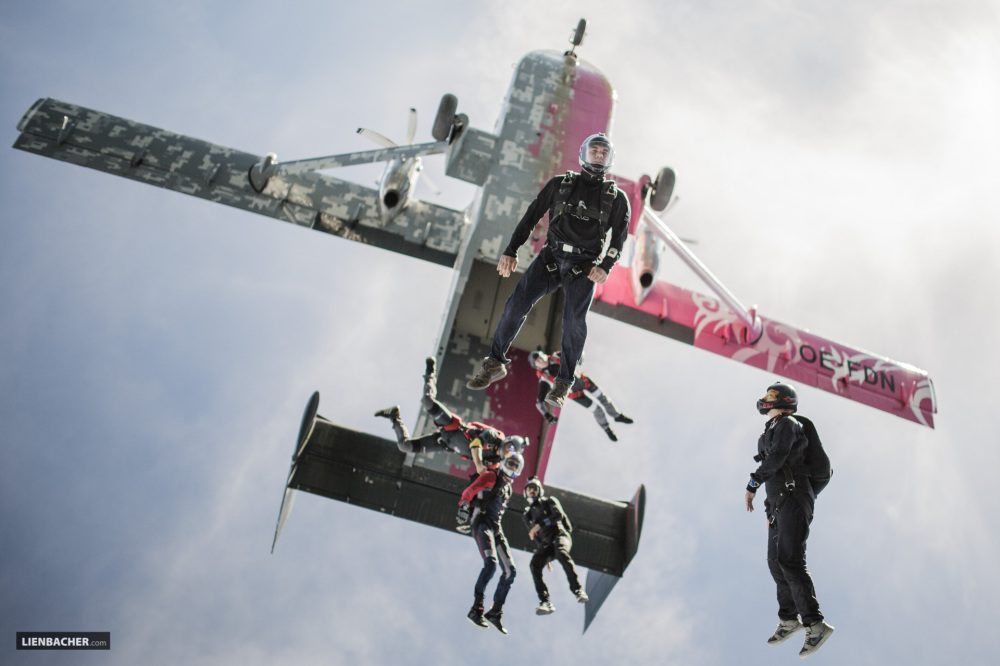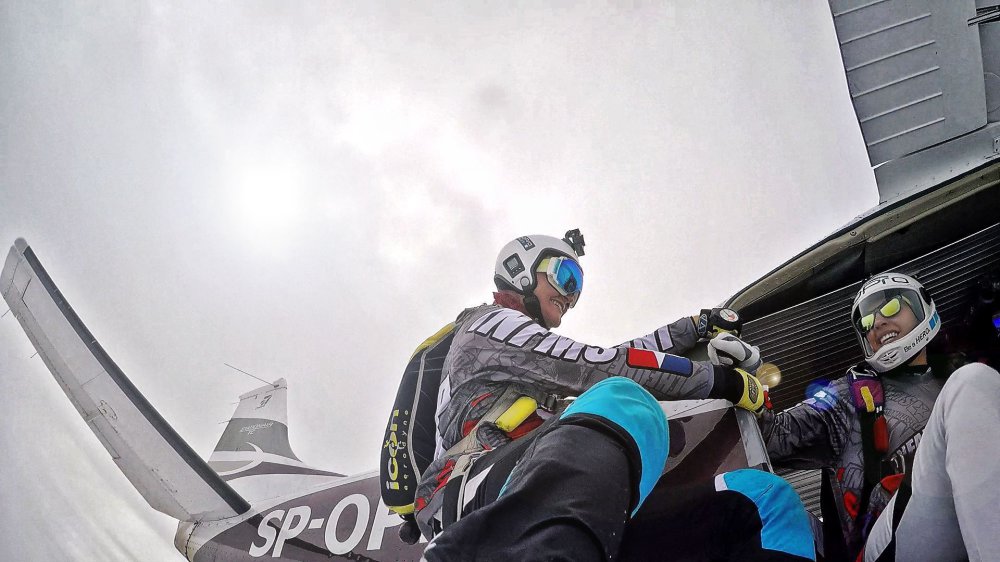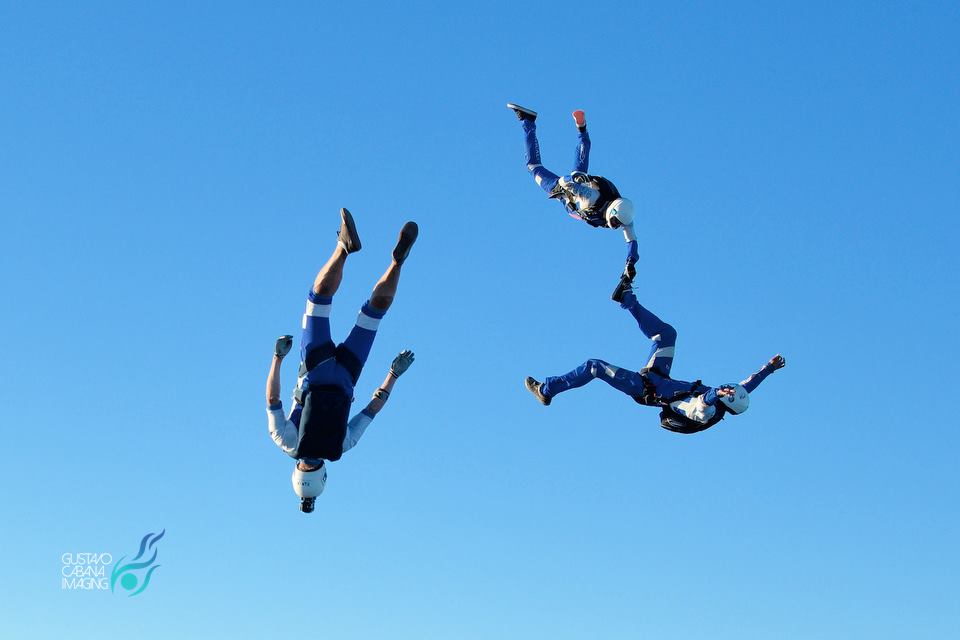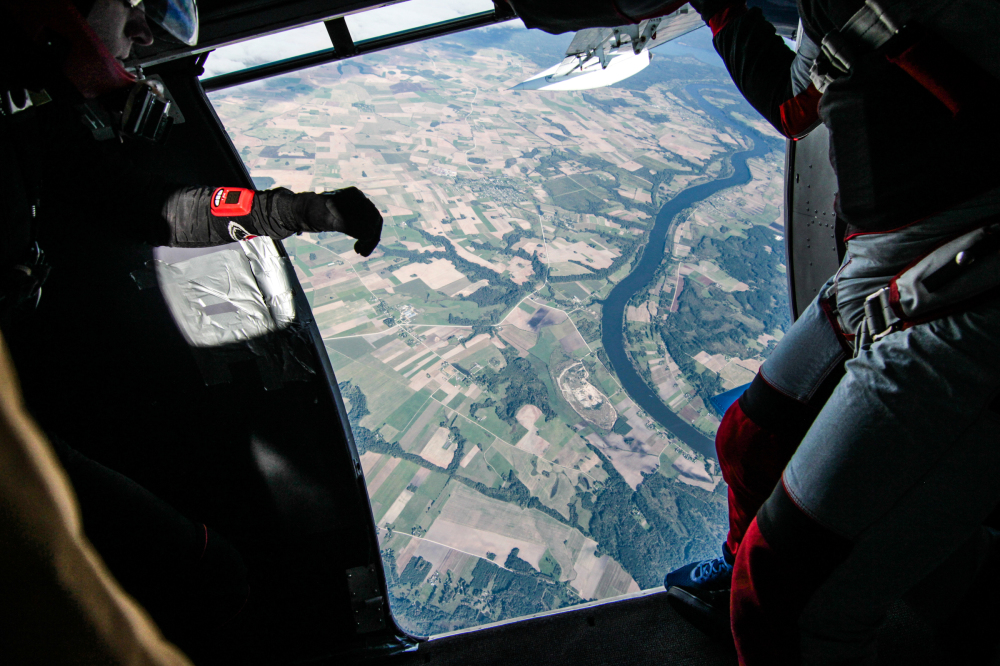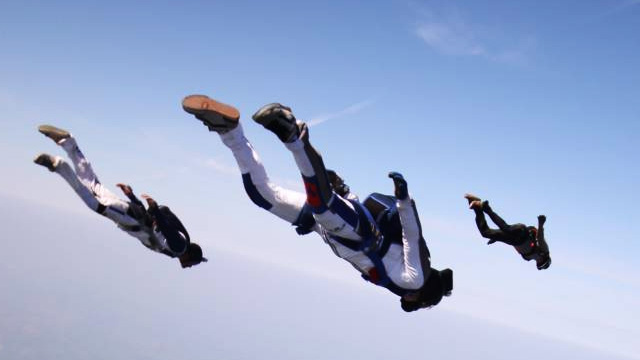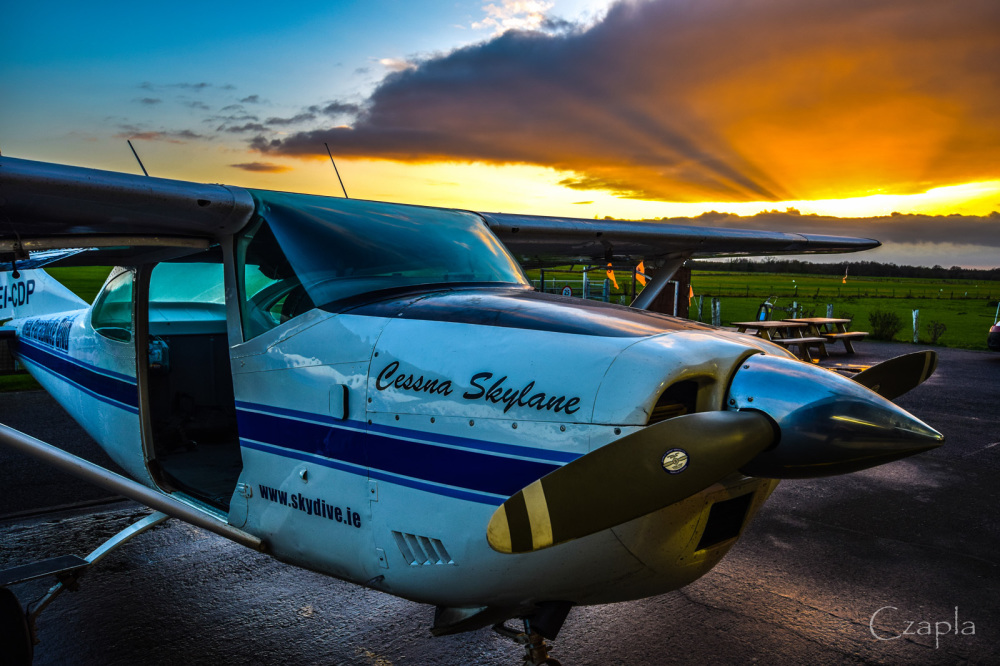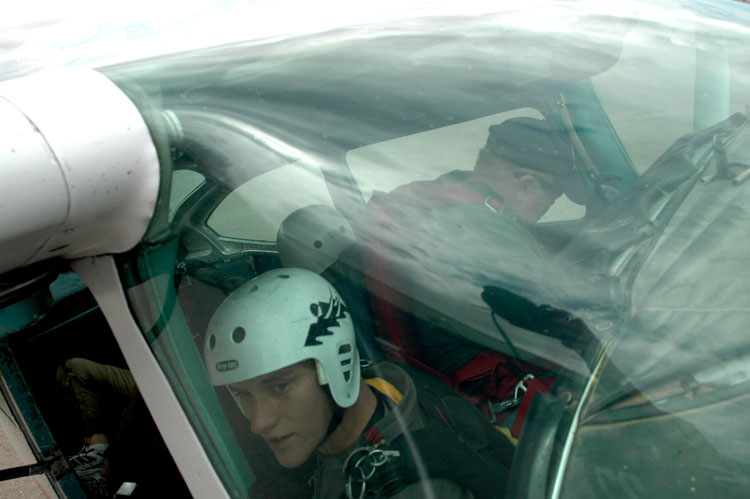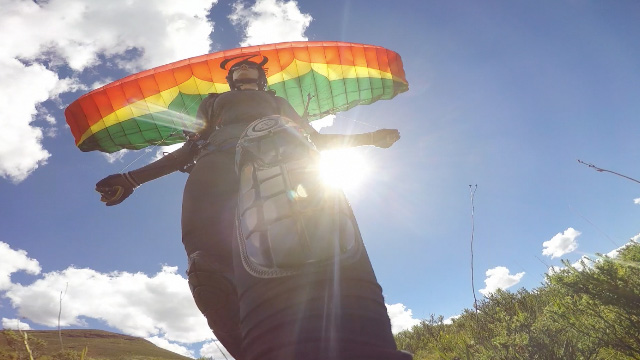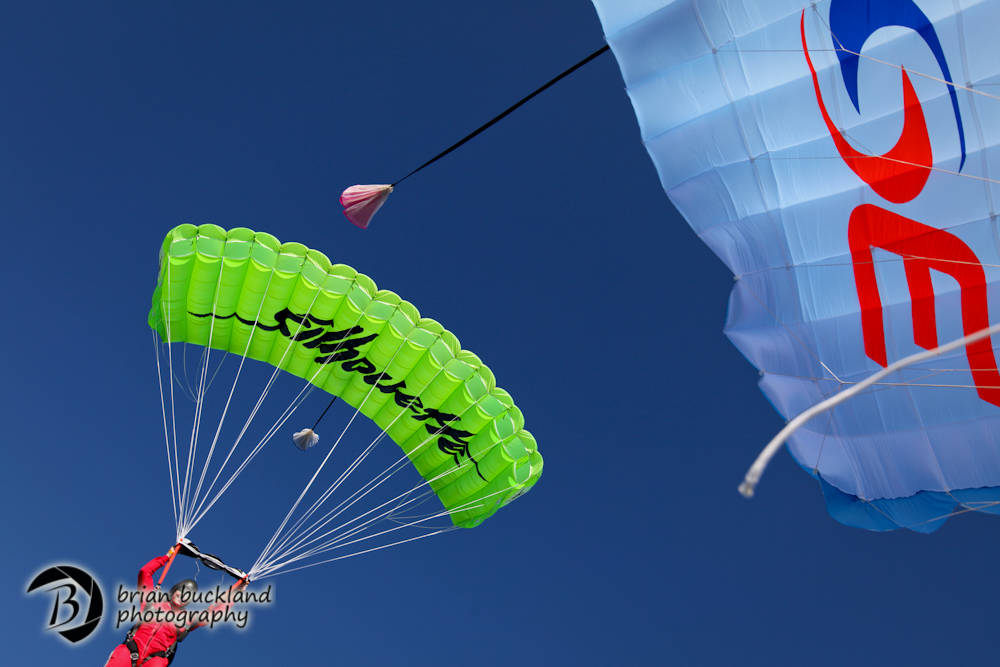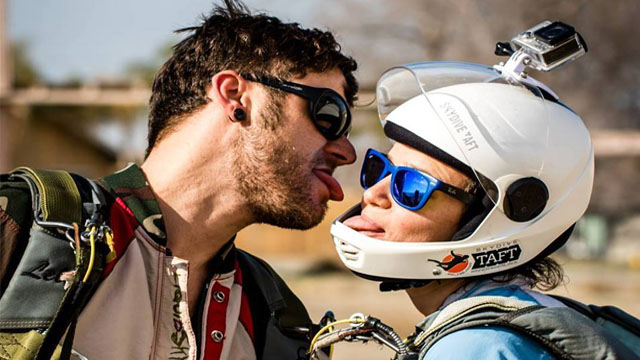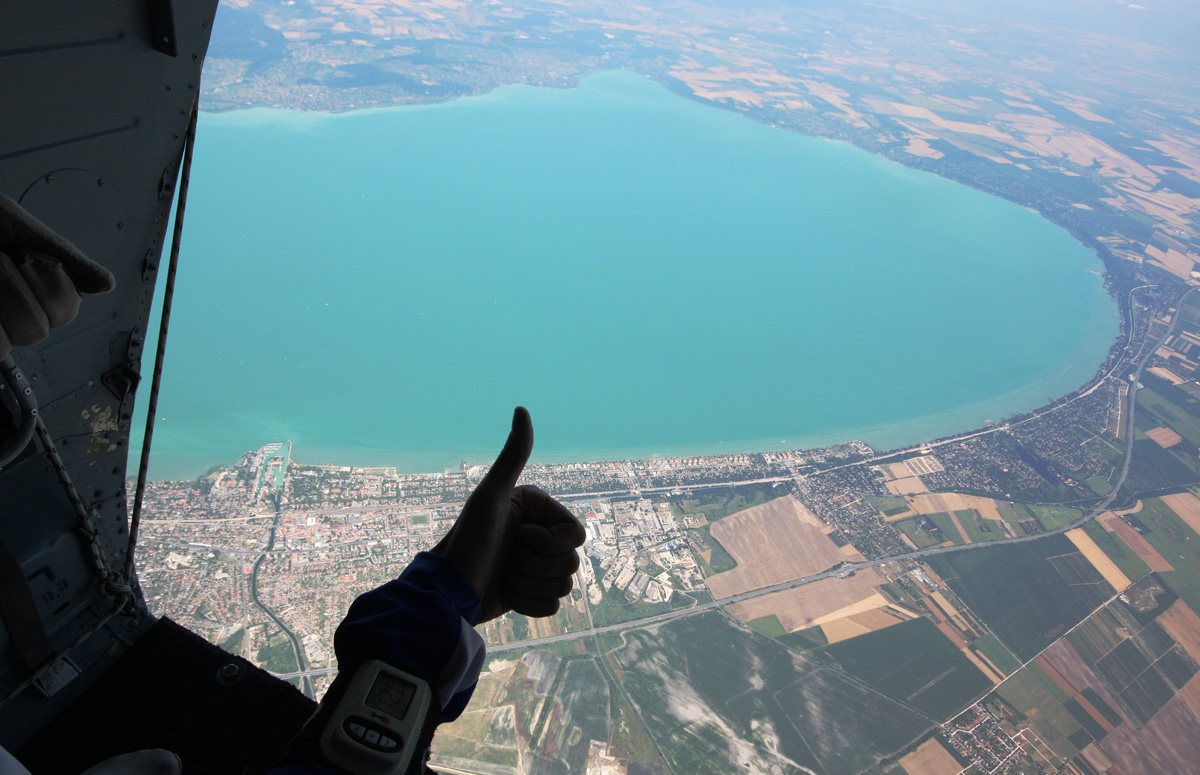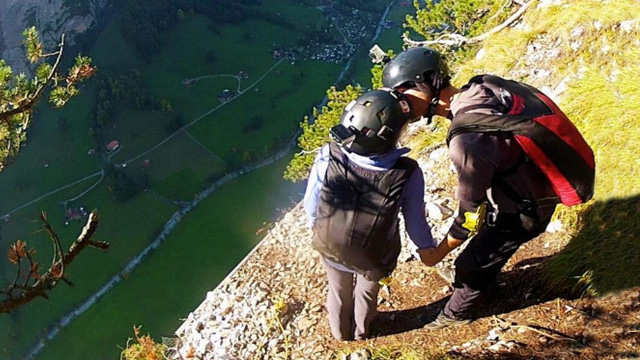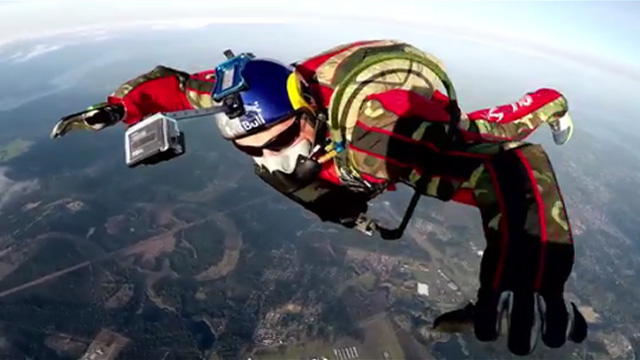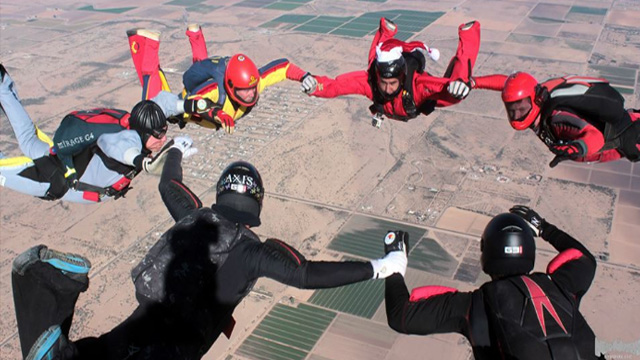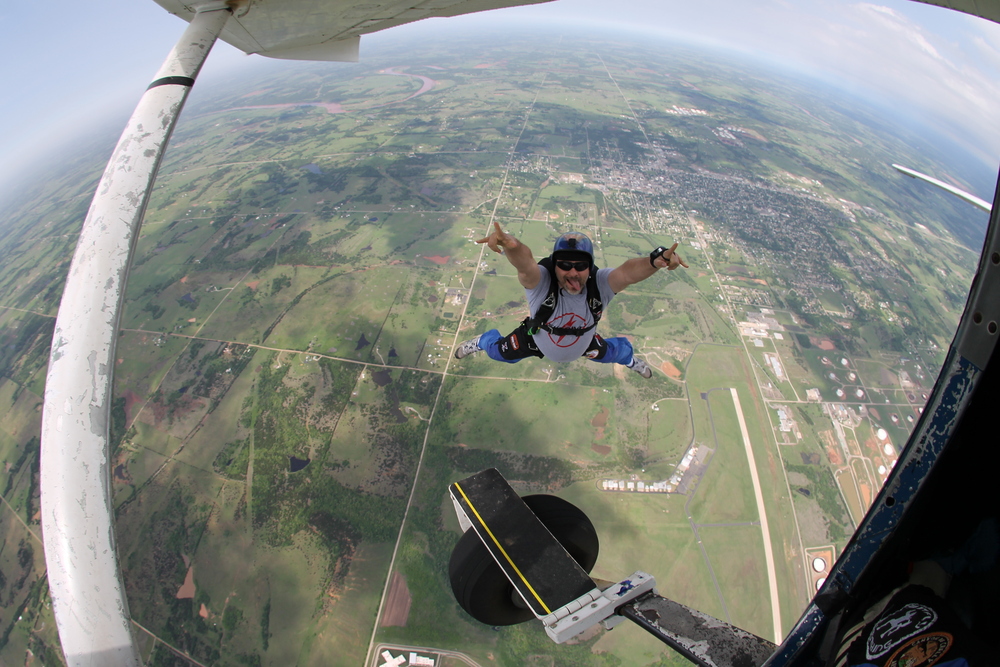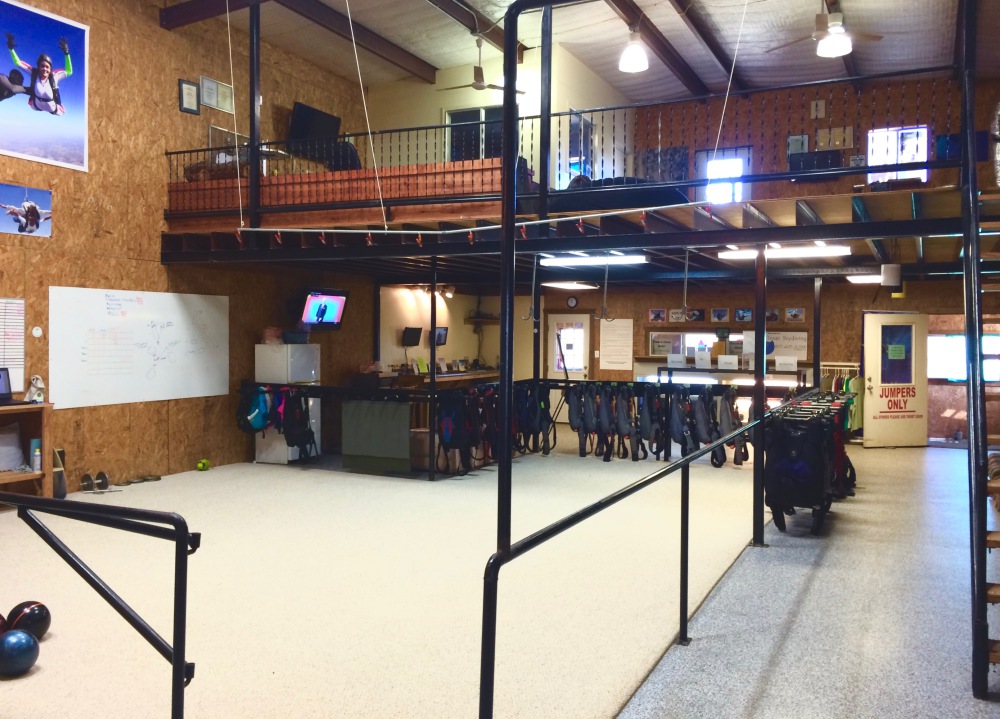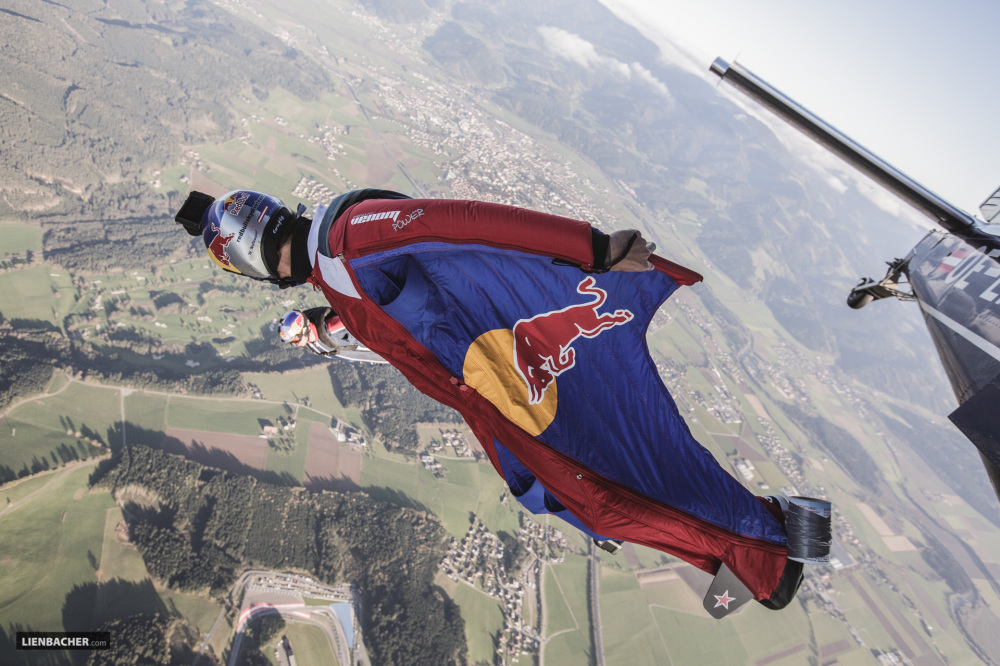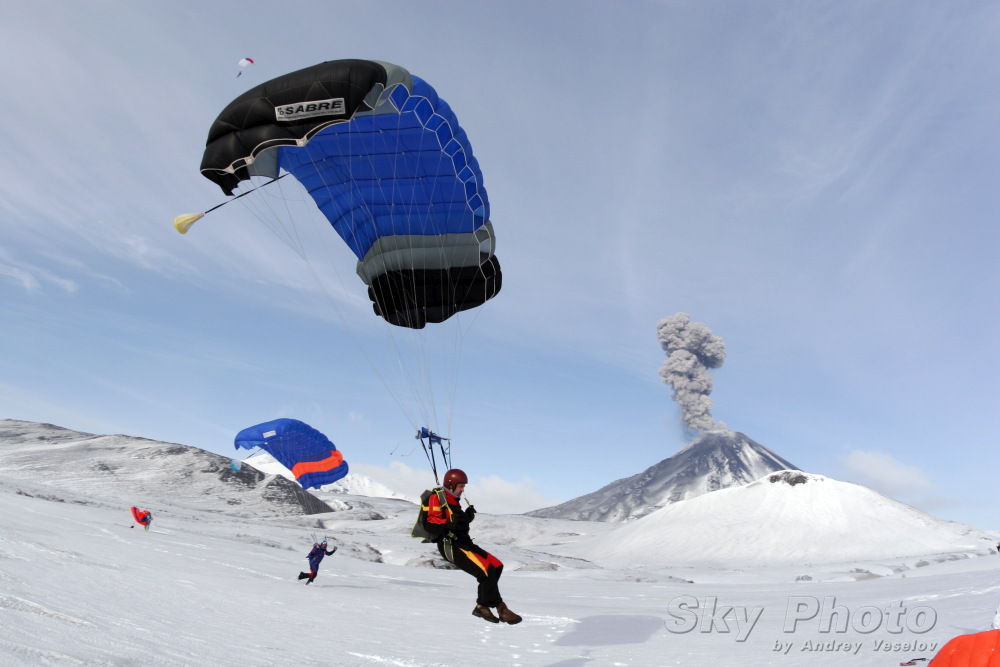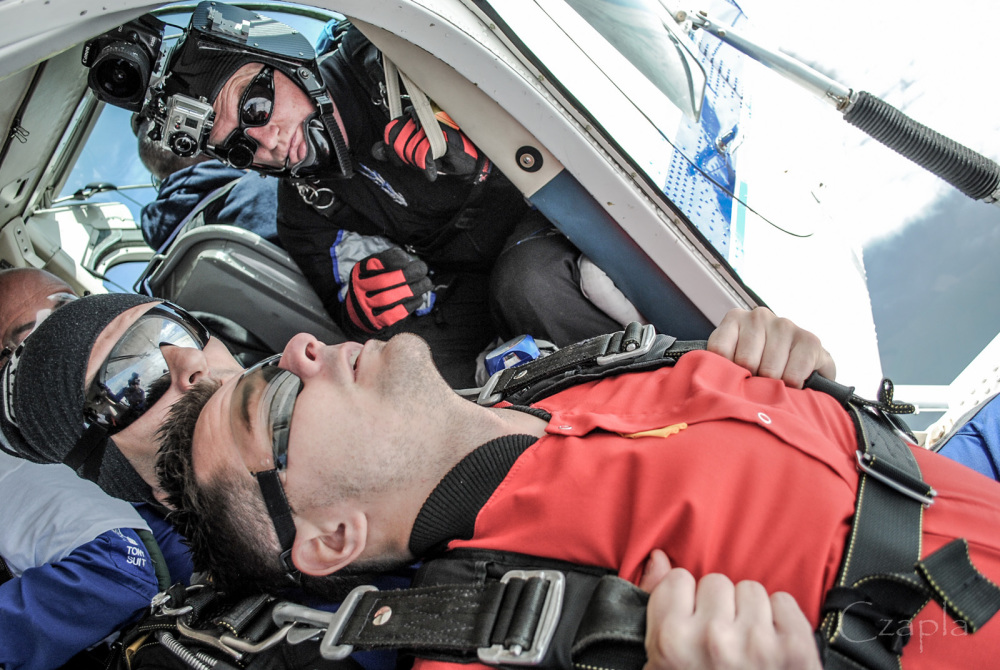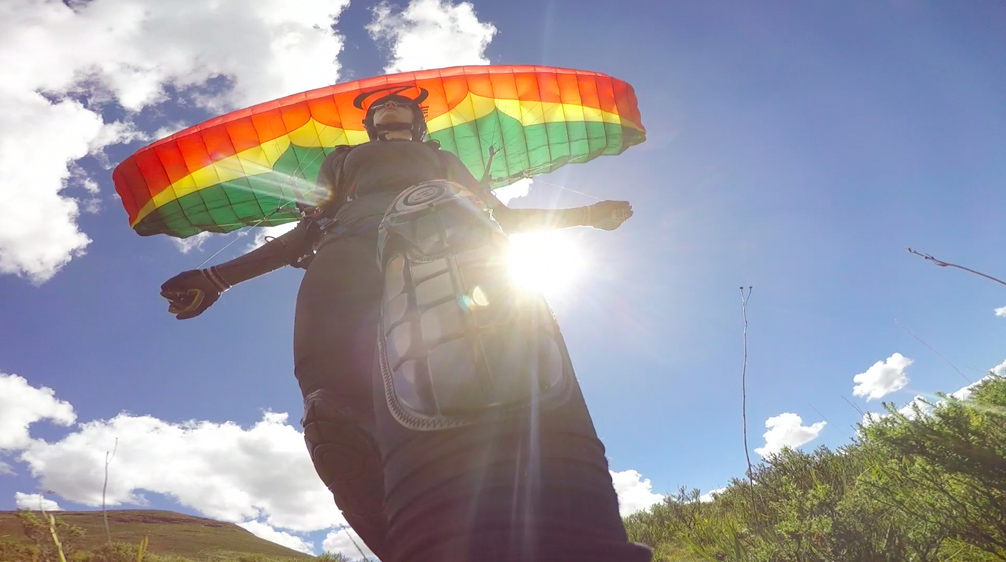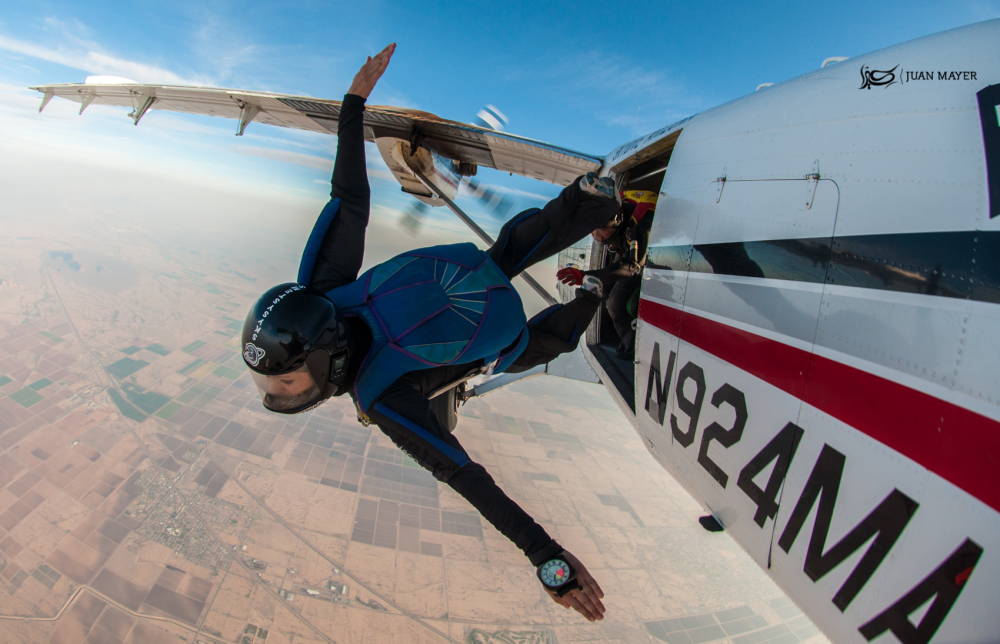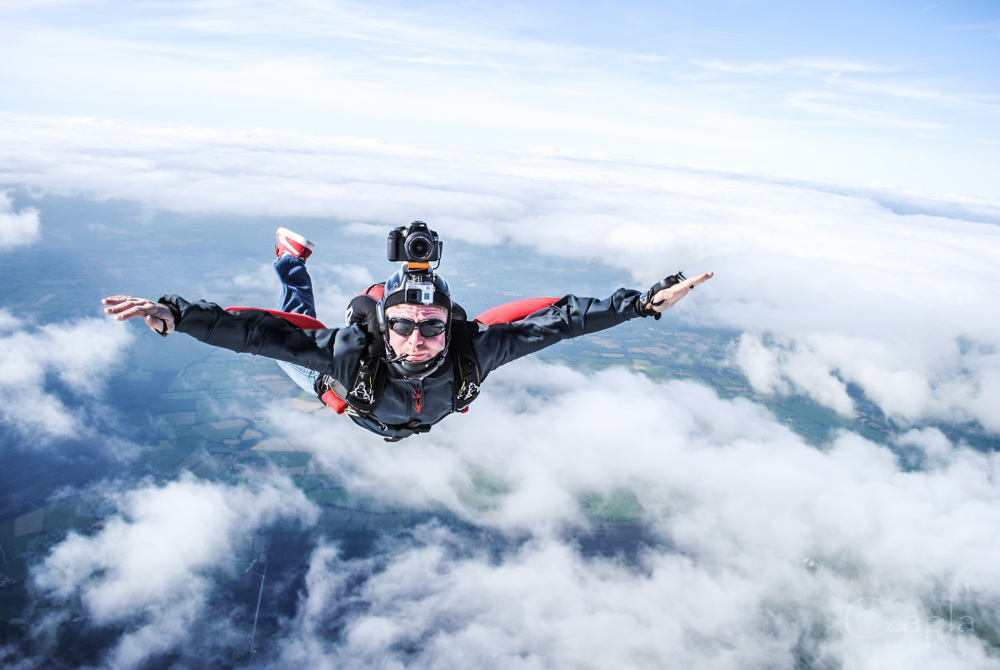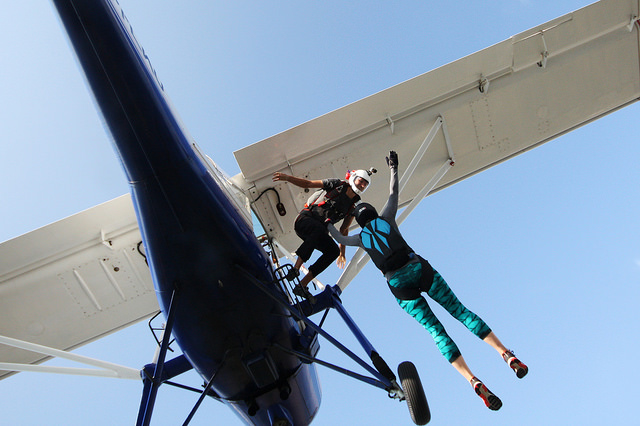Search the Community
Showing results for tags 'general'.
Found 265 results
-
How To Jump Smart When You've Got Asthma Photographer: Wolfgang Lienbacher Ah, the sky: the beautiful bubble of air that surrounds us all in a breezy embrace.But what if your lungs have a troubled relationship with that air? If you’re an asthmatic and getting into skydiving, you’re facing a substantial--but surmountable--challenge. You’ll be happy to hear that you’re not the first to square up to the sky with flimsy airbags. Many asthmatics are successful sport skydivers. In fact, some studies show that exposure to high altitudes can even improve the lung function of people with asthma. (Ha! Take that, haters.) That said, you need to check off a few boxes on your way to the plane. Here’s a quick tipsheet. Get your doc’s signoff.If you want to be a serious sport skydiver, your asthma must be stable and under excellent control. Don’t take your own word for it, either--speak to your doctor about it. Your doctor will need to confirm that your peak flows (or spirometry) should be close to the normal range. This can be quite discretionary stuff, so get a second opinion if necessary. Unfortunately, severe, persistent asthma and skydiving are not a good mix. Know where your meds are.It’s rule number one for you in your landlubber life, and it remains rule number one in the sky: you must know where your meds are at all times. Keep that rescue inhaler readily available--not buried in a bag, floating in with the rest of your gear--and make sure other people know where it is. Making sure it’s in the pocket of jumpsuit is definitely not the worst idea--and keeping a permanent backup in your dropzone kit is a very, very good one. Go easy on yourself.Skydiving is exercise, and it’s exercise in a cold-air environment. The high altitudes we reach on sport skydives can compromise weaker lungs, reducing the oxygen in an asthmatic jumper’s blood to the point of unsafety. These conditions are challenging even for people who fall within the healthy, normal range--so an asthmatic can expect to exert proportionally more effort on each jump. Listen to your body. Don’t push it. Declare your meds.The dropzone needs to know if you’re on medication, so be clear and specific about what your treatments include. Also note that if competitive skydiving is on your horizon, you’ll need to make sure the governing organization is aware of all the prescription medications you’re taking. Anti-doping rules are in place for all competitors, and some asthma medications are on the list. You wouldn’t want to see your team’s faces at a DQ you could have seen coming. Don’t be shy. While you’re talking to your new dropzone about your asthma and declaring your meds, talk to them about the supplemental oxygen on the plane. If you’re on a long hold at altitude, don't be shy about asking for it. Be okay out of the pollen bubble.Is pollen a problem? Be aware that most dropzones around the world are located in agricultural areas. You may actually be physically landing in a cultivated crop field chock-full of pollen. If that sounds like your idea of a very bad time, you may need to get creative about where and when you jump. Make sure your bones aren’t compromised.As asthmatics are probably aware, a regular dose of oral steroids can be very bad for the structural integrity of your skeleton. If that describes you, make sure you’re thoroughly medically assessed for osteoporosis and that your bone density sits within the normal range. Learning to fly a sport skydiving parachute doesn’t automatically mean you’re doomed to crash landings, but they’re far more likely in the early days of your jumping career--and potentially much more injurious for a medicated asthmatic than for others. Brand new? Address your anxiety as early as possible.Anxiety is a very normal part of the early skydiving experience. This is true for everyone. Asthmatics--especially folks for whom emotional spikes can trigger an asthma attack--must deal with this in a much more thoughtful, procedural ways than others. The good news is that you can expect the intensity of anxiety to lessen over the course of your skydiving career; the bad news is that, in the beginning, it’s quite a hurdle to get over. Here’s a hot tip: there are plenty of ways to prepare your body for the experience. The wind tunnel is a great hack. If you take some time to acclimate your body to the feeling of freefall in this controlled environment, you’ll have proportionally less anxiety once you get into the sky. Take a tandem skydive to be introduced to the procedure, the plane, the facility and the sky. Give yourself the time to approach your sport skydiving career sideways, not overwhelmingly all-at-once, and your lungs will be that much happier in the sky. After all, it’s the sky we fill our lungs with; it’s time yours were properly introduced.
-
You Gotta Do It Right, Every Time Lead image by skydivegirlplIn the Frankenstein world of skydiving aircraft--where the original innards have been ripped out and kinda-sorta replaced here and there with lighter components--we’ve had to rethink this whole “seatbelts” thing with an eye to minimalism and ease of use. (For contrast, check out the amount of webbing with which aerobatic pilots festoon themselves.) In almost every case, skydiving has had to invent new procedures to maximize the utility of restraints while lacking the backing support of a seat. Hear this, dear readers: These “new procedures” vary in effectiveness. Very few skydivers are properly educated. The details matter. Belts for BenchwarmersAre you sitting in a comfy, capacious aircraft with side benches? Lucky you! You can enjoy the proven-safest restraint configurations available to modern skydiving. Hooray! The reason that lap belts should only be used by side-facing skydivers is that they are maximally effective when there is a solid support surface behind the occupant: a seat back, an aircraft sidewall or a bulkhead. (A particularly burly swooper doesn’t count.) Already bored and sure you know how this lap belt thing goes? Hold up. Did you know that you should be routing your lap belt between your main lift web and body when you’re sitting on a side bench?** “Whoa,” you say. “This means that the restraint belt does not simply go over the top of my glorious lap, as I am used to.” You, dear reader, are correct in that observation. Routing the male end of the lap belt between your belly and main lift web as it’s on its way to the latch on the other side is the way to go. It’s proven to make you less likely to slide out of it in the slippery, bucket-seatless context of a jump plane. Restraints For Floor FolksIf you’re on the floor, this is your huckleberry: A single Hooker belt, wrapped around a single hip, close to the ring. These aren’t as good as the big-plane lap belts, because single-side belts have a disconcerting tendency to impose massive, twisting, sideways loads on a jumper's spine. There’s also a huge flail arc for the head, which can result in significantly reduced thinking for the rest of the jumper’s natural life. That said: if it comes down to it, at least your meat stays put, inside the plane, and you don't end up suffocating your buddies at the front of the cabin. “What fresh hell,” you are probably wondering, “Is a Hooker belt?” Calm down--you’ve totally seen one. A Hooker belt is what we call single-point skydiver restraints. They’re ‘Hooker belts’ because they were invented by Jack Hooker. (If you recall, we mentioned him earlier in this series; he’s the fellow who developed restraints in response to the multiple-fatality crash in Hinckley, Illinois that claimed many of his friends.) To see how it’s done, take a little journey with me back to nineteen-ninety-something, when the FAA last took photos for its Sport Parachuting Advisory Circular. Play some Ace of Base and put your hair up in a side ponytail so the photos aren’t so jarring, then take a look. 1. Sit close to the attachment point, facing the back of the plane. 2. Pass the male end of the restraint under the upper part of the leg strap closest to the attachment point. 3. Pass it under the main lift web*. 4. Latch it close to the hip ring. 5. Aim to sit so you have a 45-degree angle between the point the restraint attaches to you and where it attaches to the floor. 6. Tighten until there is little slack. The more slack you have, the further you will travel before impacting something in the cabin in a no-bueno manner. A short leash also minimizes twisting and flail arc. Once you’ve got those methods down, it’s not over. There are a few more points to keep in mind, besides: Restraints don’t work if you can slide out. Ask the jumper who was ejected out the left door during a forced landing in Oklahoma. She was sitting with her back to the pilot and the belt only over her lap. Routing it through the harness would have kept her inside the plane, which is an excellent place to be when the plane is bouncing and crunching all over the ground. Beware the leg-strap-only method. In a tiny plane? Tempted to just tug a belt through your leg strap and fuhgettaboutit? Think twice. Crash tests have proven that single point, single tether restraints are not very effective. The direction you’re facing is actually important. Research has shown that, in order for the restraints to work properly, parachutists must face the tail (“aft”). Never ever ever share a restraint with another skydiver. Everyone on the aircraft needs to be secured individually. Yes, this is just as true for tandems. Tandem students should never be restrained by just clipping to the tandem instructor. If the tandem instructor is incapacitated during a crash, the student cannot unhook. This has killed at least one tandem student in Australia (by drowning). Don’t double up. You must have a single point of detachment to begin egress*** in an emergency. Panicky flailing, fear, fire and smoky visual impairment can all play into the ability to get out. Two attachment latches is one too many to work out in that kind of environment, as has been proven over and over again. Curb your camera. In the event of an impact, make no mistake--your flimsy little G3 is a projectile weapon, as is every loose bit and/or bob that’s rattling around your person. The length of a Twin Otter is plenty of space for them to reach ramming speed. Don’t let them get the opportunity. Leave your chest strap the hell out of this. Chest buckles are only rated for 500 pounds, while most other harness buckles are rated for five times that. If it does hold, it’ll flail you around like a demented cowboy misusing a lasso. Been in a cra...uh, forced landing? Get your gear checked out. Even though it’s a key part of how we protect ourselves from aircraft oopsies, a parachute harness was developed for deceleration from freefall, not partnering up with a restraint belt. Most manufacturers have not tested their harness configurations to see how they weather the jangling, multi-directional abuse of a forced landing. If you’ve been in a plane that’s gone down unexpectedly, send your rig to a rigger to check its airworthiness. The “tight cabin” theory simply ain’t true. Tightly packed loads do no better than their emptier counterparts during forced landings. The only thing that will protect you is a restraint system, not being shoved in like a sardine. You’re not buckling up for yourself. If you take one thing away from all this talk of restraints, remember this: When you do up that belt, it’s not for you. It’s for everybody you might crush if that plane smashes in. It’s for everybody you might fall on from the apex of your surprised-face zero-g levitation to the cabin roof. It’s for the pilot, who needs to be able to count on a certain balance of weight when shit is actively hitting the fan. And it’s for your friends--so they don’t have to stand around a bonfire in tears, wondering how to prevent it all from happening again. * The main lift web is the vertical part of the front of the harness--the webbing that your cutaway and reserve handles live in.
- 10 comments
- 7
-
- in the plane
- in the plane
-
See more
Tagged with:
-
Image by Gustavo Cabana Looking back across a season of high profile competitions and seeing professional teams across many different disciplines throw down their best performances can have a powerful effect on the imagination. The pull towards the ziggurat of organised competition can be strong - but what you ultimately witness is the end product of a lot of time and effort, so it important to know exactly what you might be getting into and addressing some front-end considerations will help you get on the good foot. What really goes into starting a skydiving team? What are the advantages and rewards in the immediate future and then further on down the road? Also, what are the costs and compromises - both obvious and perhaps less so? There are different ways of making a team happen. Some countries have a national skydiving organisation that plays an active role in the selection and training of talented individuals for the purpose of competition (e.g. France - who recognise parachuting as a national sport), although the more normalised method is whatever body controls the skydiving interests in your country will have an application method for allocating support to functioning teams with a valid performance history - which means at the beginning and for the foreseeable future you are likely on your own. Other possibilities exist: Private coaching operations such as Satori Academy (www.teamsatori.co.uk) conduct season-long programmes in which a pool of students are seeded into teams of appropriate skill with the intention of building towards competition. Also sometimes already established teams might lose a member (for any number of reasons) and seek a replacement via. application and/or audition. However, by far the most probable beginning is that you and a group of friends that regularly jump together and socialise in the same circles will pass the idea around a bit and have things grow from there. You are practically a team already right? All you need is a cool name and some matching shit and glory awaits. Right? Image by Simon Brentford Now What?The first thing that happens once you commit is you will become filled with motivation. Outwardly nothing has changed - you are the same gaggle of mismatched skydivers you were this morning, yet now you have a purpose! The machinery inside your head will be whirring and whizzing about all the things you might achieve. The clearest immediate payoff from the decision to compete is this sense of purpose. It is very easy to get lazy when skydiving and fall into patterns of the same comfortable familiar behaviour - always flying your strong ways, always swooping the same direction - never training the wonky side or pushing yourself forward. Having the date of your first competition marked on a calendar by which you have to achieve specific things is a really good method to highlight how much more you could be getting out of your jumps right now - and the extra things you could be learning around the edges from all the different sources of information available out there. Also - the format and structure of competitions themselves are are designed to test your range of ability. The various dive pools for FS or VFS (and MFS!), the compulsory moves for Artistics and the indoor ruleset cover the full range of movement you have been using for your casual flying. Learning and practicing these will strengthen your knowledge and draw attention to weak areas where you need focus and improve. Image by Jim Harris Things To Consider:It is easy to get excited about all of the great things you are going to achieve. Your new teammates might all be present and correct for the boozy bar talk of world domination, but how much is everyone really committed to the idea? When it comes down to the early starts on cold mornings is everybody going to actually be there? Also, the way you interact is going to change. The kind of mistakes that make for fun stories over a weekend of jumping might well create tension and arguments when there is more on the line. Competing can bring many rewards and be a lot of fun but it is also hard work. By introducing a formal element into your skydiving you risk making it into just that - work. Examine why it is that you skydive and have the others do the same. What do you realistically hope to achieve from teaming up? What are the trade-offs exactly? You could see it as being more serious across the board in return for deeper rewards, or a motivating way to throw money at your passion and improve much faster than before. Team skydiving is worth the effort for many reasons, so if you are in a position to do so then don’t let any possible negative elements dissuade you - but examining potential hiccups and conflicts of interest early on can help everything to run smoothly from the beginning.
-
A Seatbelt’s Job Goes Beyond The Crash Think your seatbelt only helps you when the metal hits the dirt? Nope. The magic of seatbelts goes far beyond the prevention of injuries and fatalities during actual impacts. Seatbelts also help the plane fly better and move more safely during maneuvers, sometimes preventing that impact from even occurring. The first way seatbelts do this is by helping to moderate the weight and balance of the aircraft. Limiting the numbers of jumpers on board to the number of seatbelts limits the risk of overloading the plane, which we all know is a bad scene (slower acceleration, sloth-like climb, stall danger due to higher stall speed, and the like). It also keeps the wiggly weight of the passengers pinned in place, helping the pilot maintain control. Take an example. One day, a Cessna 205 aircraft ran out of fuel just after takeoff from Celina, Ohio. (Everyone on board--the pilot and five parachutists--perished in the incident, so witness reports and NTSB investigation reports are all we have to explain what happened.) DiverDriver.com explains that, of the witnesses that reported hearing the airplane during climbout, each “described smooth engine noise, brief ‘sputtering,’ and then a total loss of engine power. The airplane descended straight ahead at the same pitch attitude, then the nose dropped, a parachutist exited, and the airplane entered a spiraling descent.” That first jumper left from the student position--as the door was under the wing and not in the rear like the Cessna U206. His exit abruptly shifted the weight aft, rendering the aircraft uncontrollable. Two more jumpers attempted to exit. The all three jumpers who exited the aircraft were unable to deploy parachutes. Everyone left in the aircraft perished in the violent resulting crash. Another sacred duty of the seat belt: to help the pilot maintain precious, tenuous drabs of control during violent maneuvers in the lower end of the altitude spectrum. Belts hold skydivers in place during the top-gun shit that pilots have to pull sometimes in order to avoid mid-air-collisions, stopping meat from rattling around the cabin and coming down unbalanced. Note: As skydivers. we’re at pretty serious risk for these, because this kind of incident is statistically most likely to happen in the crowded, lackadaisically-controlled airspace around the small airports we tend to frequent. When two planes go head-to-head, pilots are taught to pull power and dive to the right--which slams un-belted jumpers right up into the ceiling. The landing is a mystery, but if too many of them land too far aft, the airplane will be unbalanced, stall and spin. Whee. Ugh. “Sure,” you say, “But that shit hardly ever happens.” Au contraire. In the next installment, we’ll take a look at the long list of recent incidents you haven’t even heard about--and meditate on the totally-coulda-been-you aspect of the thing.
- 7 comments
- 7
-
- in the plane
- in the plane
-
See more
Tagged with:
-
By Bryan Burke, S&TA; at Skydive Arizona I’ve been taking notes on incidents related to the risks of horizontal freefall activity. Browsing the Incidents Forum on Dropzone.com leads to some interesting information. I went through the first six pages of the Incidents Forum to mine the following data. There are eight instances in the past year where an AAD fired after a freefall collision or related incident incapacitated a jumper, and a ninth in which the victim’s fellow jumpers pulled for him. The reference date is that of the first post, not date of accident. 1: July 31, 2013. 9-way tracing (angle flying) jump, reportedly very experienced jumpers. Collision at break-off due to back tracking blind into another jumper. AAD fired. Collision injuries followed by landing injuries, including skull fractures. 113 reserve, wing loading not stated. He jumps a Velocity 90 for a main, which suggests a fairly high experience level. If we assume a typical Velocity wing loading is 1.8, that would put the reserve wing loading at 1.6. PD recommends that expert skydivers limit wing loading on the PD113R to 1.4. 2: July 15, 2013. On a tracking dive, a jumper with 1,000 jumps was hit by one with 300, hard enough to lose awareness and probably unconscious for a few seconds. Two skydivers docked AFF-style and one opened his main for him. Fortunately the main, a Crossfire 2 119, opened without incident and the jumper recovered high enough to take control and land it safely. This was a 12-way dive according to the Youtube post, but you can never see more than ten people and they are at multiple levels. The collision occurs during the early stages of the dive, as the trackers are forming up, which gave two expert jumpers the opportunity to dock on him and pull for him. Had the collision happened lower, or had the jumper not recovered to land his parachute it could have been much worse. If he is jumping a Crossfire 2 119, he probably has a pretty small reserve, too, so an AAD deployment of the reserve might not have ended well. 3: July 10, 2013. 12-way tracking dive at a boogie results in a freefall collision that knocked out one jumper. His AAD deployed the reserve (estimated at a conservative 1.1:1 wing loading). The jumper had some teeth knocked out and fractured three vertebrae, C1, C5, and T5. His reserve was reportedly distorted by line twists or perhaps a knot or line over which might have been the result of deployment on his back. He was fortunate to land in an open field. The jumper later posted that he would recover. His profile says he has 325 jumps in two years. There is no explanation of who or what caused the collision. 4: May 27, 2013. On a 3-way RW dive, an experienced jumper with 3,000 plus jumps was laying base while two other jumpers, one with about 150 jumps and one with about 100, dove out after him. The one with 150 jumps dove too aggressively (a very common mistake when learning to dive out) and collided with the experienced jumper, hitting him in the head with his legs. The experienced jumper was knocked out and stayed that way through the freefall, the AAD activation, the reserve ride, and the landing in a tree, under a reportedly conservative wing loading. The experienced jumper died, although it is not clear if from the trauma from the collision or the landing. 5: May 20, 2013. A fairly experienced jumper, last out on a tracking dive and diving hard to the formation, hit the foot of another jumper and was knocked out. The AAD deployed the reserve as designed, which was followed by a safe, unconscious landing on a PD 160R which was loaded at 1.25. A later post by the jumper himself says it was an 18-way tracking dive. His profile says 700 jumps in six years. He apparently overtook, horizontally, a jumper who was above and ahead of him and never saw the jumper he collided with. The other jumper would not have seen him coming, either, with all of their focus ahead. 6: February 17, 2013. A skydiver was knocked out on a 10-way tracking dive. Their AAD activated but they were injured from striking a fence on landing. The injured jumper had 180 jumps and it was her first tracking dive. The injuries include a neck fracture but no paralysis. Her full-face helmet showed some damage. The reserve was lightly loaded, an Optimum 193 but no exit weight reported. 7: February 14, 2013. A skydiver with 60 jumps had a shoulder dislocated while participating in a 12-way Formation Skydiving jump. Apparently this was the result of a hard dock from another jumper docking on the injured jumper. There is very little detail, but apparently the jumper could not open a parachute and the AAD did the job. No report of landing injuries. 8: December 7, 2012. On a 17-way wingsuit jump, a participant with 250 jumps struck another participant in freefall and was knocked out. His AAD worked but he remained unconscious under canopy, crashed into an obstacle, and died from that or a combination of the landing and freefall injuries. The other jumper had unspecified back injuries. 9: October 22, 2012. On a wingsuit rodeo jump, witnesses reported that the jump tumbled unstable from exit. At some point fairly high, reportedly around 10,000 feet, the rodeo rider left. The wingsuiter never deployed a canopy. Their AAD fired but the reserve did not deploy. With no witness to the lower part of the jump it is impossible to say if the wingsuit jumper was struck by the rider, or had a stability issue such as a flat spin. Of nine incidents in ten months where a jumper was incapacitated in freefall and their AAD fired (or in one case, was deployed for by another jumper), seven out of nine involved trackers, tracing, or wingsuits. That’s 77%. Eight of nine, or 88% were definitely due to collisions. The final one is uncertain but possible, if it was also due to a collision, that brings us to 100% of the incapacitations being due to collisions. Almost all of the incidents involve some degree of inexperience. Just how much experience is required to participate in this type of jump is relative. For example, is 300 jumps enough to be on a 12-way tracking dive? Is 250 enough to be on a 17-way wingsuit dive? Is 180 enough to be on a 10-way tracking dive, with no previous tracking experience? Is 700 jumps over six years (117/year average) enough to be on an 18-way tracking dive? Is 325 jumps in two years enough to be on a 12-way tracking dive? If your jump numbers are low (say, below 500 jumps) you may have answered “yes.” The correct answer is “no.” In every case except 9 and 1, it’s pretty safe to say these dives were too big and too poorly planned for the experience levels involved. In the case of the wingsuiter with 250 jumps, for example, if he was in compliance with his national club’s policy, he could not take up wingsuiting until he had 200 jumps. Even if all 50 of his next jumps were wingsuit jumps, did he have had the experience and skill to be on a 17-way flocking dive? What if only ten or twenty of those 50 jumps were with a wing suit? Go to Youtube and search “skydive tracking dive.” Here is a glaring example of the issue: This took place at a big US drop zone with plenty of experienced skydivers. Pause this dive every couple of seconds. At various points you can see that up to fifteen (maybe more) people are on the dive, but throughout the dive you’ll see people flailing unstable, going low, unable to close on the formation, way above it… and at break-off time, it’s really down to a six-way with a couple other skydivers in the distant rear. For some reason – and here, logic completely fails me for an explanation - some people seem to think it is cool to go on a skydive on which at least half the participants lack the skill to manage the simplest goals such as approaching in control, staying in proximity with the leaders, and breaking off in a controlled fashion. Now with all those bodies scattered around the sky, many of them without the experience to have developed good air awareness, what do we expect would happen? Of course there are going to be collisions, although apparently there were none on the dive used as an example. The experienced jumpers at that drop zone, and every other one, need to change the tune. These jumps should be hard to get on, not easy. Participants should prove themselves on small dives before they go up on big ones, just as in any other freefall discipline. We don’t have a very big data set to go on, but let’s say that tracking, wingsuit, and angle dives are 10% of all skydives made. That would probably be pretty generous, my instincts would put the number at under 5%. Yet they account for about 75% of all AAD saves from incapacitation in the past year, and 50% over the past six years. (Half of all the saves due to incapacitation in freefall that show up on the CYPRES web site in the past six years occurred on tracking, angle, or wingsuit dives.) So if a subgroup making 10% of all skydives generates 50% of the AAD activations due to freefall injury, is that a problem? Tracking dives have become the most dangerous form of freefall there is. Wing suits are in second place. Tracing/atmonauti/angle dives appear to be determined to compete for the distinction. I hate to load my staff and myself up with more work, but self-policing simply isn’t working in this situation. Skydive Arizona is going to start holding the horizontal element of skydiving to much higher standards. We expect to have minimum experience levels for participation at different levels of complexity established soon, and our web site already lists our expectations. See www.skydiveaz.com, click on “Experienced” and review the safety materials. As a business, we need to protect ourselves and our customers from skydivers who don’t have the experience, training, or sense to stay out of trouble. As the variety of freefall and canopy choices expand, it appears the number of skydivers fitting that description is expanding too. Drop zone operators can’t simply turn a blind eye to the problem, especially since the poor planning combined with lack of experience and training expose all skydivers on the plane to a significant risk, not just the individual participant. Related Reading: The Horizontal Flight Problem
- 21 comments
- 27
-
- general safety
- general
-
See more
Tagged with:
-
You Probably Aren’t Aware of All These Oopsies Screengrab of the 12th May 2016 Lodi incidentSeatbelts help. You probably get the picture by now. But do you know just how many lives they’ve saved in the past couple of years alone? Oh, man. Loads. At time of publication, USPA dropzones use seatbelts. Even the legendarily non-USPA maverick dropzone at Lodi had seat-belt use essentially imposed on it--which resulted in all souls walking away from that dropzone’s 2016 Cessna Caravan forced landing in a vineyard. The pilot suffered a bloody nose. (He was not wearing a shoulder belt--nor his emergency bailout rig. Tsk tsk.) They were shaken, but okay--and they haven’t been the only ones. Over the last couple of years, forced landings all over the world have seen most of the jumpers survive, in great part because of that friendly webbing. On December 4, 2014, A Cessna 205 out of Sussex, New Jersey suffered a total loss of engine power during its initial climb. The in-cabin video shows the forced landing going smoothly until the nose wheel dug into a muddy field and flipping the plane onto its back. All five seatbelted souls on board survived with minor injuries. Also in December of 2014, a Cessna 182 in Beromunster, Switzerland lost power shortly after take-off. The aircraft broke its nosewheel in a field, but all five occupants--seatbelts fastened--made it out with bumps and bruises. On May 10 of 2015, an Antonov out of Azov, Russia experienced high engine temperatures that forced an immediate landing. While the crash was severe enough that a post-landing fire destroyed the fuselage, all 13 (seat-belted) occupants got out in time, and survived with minor injuries. On June 29 of 2015, a Cessna 182D out of Oak Harbour, Washington lost engine power. It struck a tree during the forced landing, which was short of the runway. The impact split the fuselage in two at the instrument panel. Unsurprisingly, the pilot was seriously injured (but survived). One passenger was injured after being ejected from the open fuselage. On July 12 of 2015, a Cessna took off from Barnegat County, New Jersey. The crankshaft failed shortly after take-off, forcing a landing right on the highway. The traffic camera shows the plane landing on the right lanes and rolling onto the grass median towards the end. The pilot and all four passengers survived with hardly a scratch on them, thanks to their seatbelts. On July 7 of 2015, a Cessna Caravan lost engine power shortly after taking off from the desert dropzone in Dubai. The forced landing into the sand dunes started a fire that consumed the airframe, but everyone--including the pilot--was able to unfasten their seatbelts and get out before it burned up. In August of 2015, a Turbo Finist carrying a pilot and ten skydivers crashed shortly after taking off from Casale Monferrato, Italy. The impact of the landing bent the wings, broke the main undercarriage legs and smashed the engine compartment. Everybody wore seatbelts. Everybody walked away. In October 2015, a Yak-12 carrying three skydivers force-landed in Poland, hard enough to break the main undercarriage. The video starts with a glance at their fastened seat-belts and ends with them running away from the wreckage. Later that October, one of Dubai’s Twin Otters crashed on landing. Only a pilot was onboard. He survived, despite major damage to the airframe, thanks to his handy webbing. On April 28, 2016, an antique biplane lost power and force-landed near Osage in the American midwest. The pilot plus two skydivers put the airplane at gross weight, and both skydivers stood on the lower wing, grasping the front cockpit edge. This created more drag than usual for what was originally a two-seater trainer with only 220 horsepower. The plane never climbed very high and force-landing in a field, hard enough to break both main undercarriage legs. The "safety straps," as sketchy and unofficial as they must have been, kept those skydivers onboard during what must have been one hell of a clenchy forced landing. (For comparison: a couple of years earlier, another skydiver was incapacitated by carbon monoxide--because he had been holding on right behind the exhaust--and fell from the lower wing of a PT-17 biplane at an altitude too low to open a parachute. If that jumper had had a safety strap, they’d be alive today. Thanks to rockstar Sebastian Alvarez’s video, most of us are familiar with the May 12, 2016 crash of a Cessna 208 Caravan at Lodi. Engine failure shortly after takeoff forced a landing. During the roll-out, the plane struck a truck and rolled into a ditch, inverting at low speed. When the airplane ground to a halt, the entire load was hanging from the ceiling. All 17 skydivers exited uninjured. The last frame of the video shows the pilot washing blood off his nose--which shoulder belts would have prevented. On July 3, 2016, a Cessna 206 out of Gilchrist, Texas had to land when an engine broke a connector rod shortly after take-off. The pilot landed upright on Crystal Beach. There were zero injuries. On August 3, 2016, a Cessna TU206 lost power 1,000 feet after its takeoff from Skiatook, Oklahoma (which, coincidentally, sees more than its share of aviation mishaps) and had to come down in a grassy field. The impact buckled the airframe in a major way, but everyone was belted. All seven occupants survived with minor injuries. Quite recently to this publication--In September of 2016, in fact--a plane out of DC Skydiving had to land right after takeoff. All 11 skydivers and the pilot wore seatbelts, and all walked away uninjured. The plane didn’t fare so well.The thing about seatbelts, of course, is that they don’t work if you don’t use them--or if you use them wrong. In the next installment, we’ll talk about how to use a seatbelt on a skydiving plane, ‘cause there are some sketchy little myths floating around.
- 2 comments
- 3
-
- in the plane
- in the plane
-
See more
Tagged with:
-
The History Lesson You Never Got Image by Lukasz SzymanskiIf you look at the National Transportation Safety Board (NTSB) reports, DiverDriver.com, our own Dropzone.com and the world’s newspaper reports, you’ll notice something interesting: the last couple of years were bad for forced landings, but good for survivors. Since December 2014, the total has been 18 forced landings, involving more than 100 occupants--but only one fatal crash (the May 2016 tragedy in Hawaii, the circumstances of which were too violent for safety restraints to have helped). Every incident is, of course, multifactorial, but there’s a simple reason that more skydivers haven’t been grievously injured or killed in these crashes: correctly installed, correctly used seatbelts. In an incident that involves a loss of power after takeoff and forces a landing, it’s seatbelts that save the jumpers’ (and pilots’) hides. It hasn’t always been this way. Seatbelts for skydivers used to be just as casual as seatbelts for motorists used to be, in the good-old-bad-old days. In the late 1970s, very few jump planes had seat belts. Single-Cessna DZs flew third-hand airplanes that were gutted to reduce weight, while large "destination" DZs flew World War 2 surplus DC-3s and Beech 18s. These war-surplus airplanes had been through so many different owners, and gutted so many times, that the original seat belts were an ancient memory. A few rare jumpers counted themselves lucky if they had a frayed cargo strap to hold onto. A Change in PolicyThen a series of bloody accidents in the early 1990s forced the FAA to enforce its preexisting FARs requiring seatbelts for everyone in the sky. These FARS require all skydivers to be seated and belted in for taxi, take-off and landing (as and when that eventuates). It’s easy to forget why this maybe-sometimes-silly-seeming rule was set down, but there’s lots of scar tissue to back it up. Our POPS mamas and papas learned the hard way, so we don’t have to. The first tragedy in this particular series struck at Perris in April of 1992. Contaminated fuel caused a Twin Otter--containing two pilots and twenty jumpers--to lose power at 200 feet over the runway. The engine failed, and the pilot feathered the wrong prop, causing a total loss of thrust. When it came back down, the aircraft over-ran the runway into a drainage ditch. The airplane slammed to an abrupt halt. The fuselage collapsed all the way back to the bulkhead at the rear of the cockpit, killing both pilots instantly and sliding the unbelted skydivers to the front of the cabin, crushing or asphyxiating each other in the process. Six skydivers were taken to the hospital with serious injuries. Sixteen died. (For a detailed account, read survivor Dan Brodsky-Chenfeld's book, "Above all Else." Make sure you have Kleenex available when you do.) The second pivotal crash occurred Labour Day 1992, in Hinckley, Illinois. That day, a Beech 18, full of holiday tandems, lost an engine shortly after take-off. They never climbed high enough to bail out. The pilot prepared to force-land in a farmer's field, but got too slow when he reduced power on the good engine. The Beech stalled, flipped and dumped the unbelted jumpers on their heads. Everyone on board was killed. At one of the many, many Hinckley ash dives, Jack Hooker brought a keg of beer and told the gathered mourners that he had been working on a solution. He had installed prototype seatbelts in the Cessna 182 that hauled jumpers during slow days at Hinckley. He sewed custom seatbelts for aerobatic, glider and warbird pilots. It’s a good thing he was on it. Over the winter of 1992/1993, the Federal Aviation Adminisration laid down the law for the USPA: either make seatbelts fashionable, or suffer industry-crushing regulatory consequences. From there, the USPA did a commendable job of popularizing seatbelts among skydivers. During the first AFFI course of January 1993, candidates were told to belt themselves in before taxi or they’d fail the evaluation dive. At the time, it was revolutionary, but the policy was vindicated a few months later--in the spring of 1993--when another Twin Beech crashed near Xenia, Ohio and everyone onboard survived. Soon, seatbelts became the new norm almost everywhere. No Guarantees“Almost everywhere,” unfortunately, hasn’t been able to save everybody. In July of 2006, a Twin Otter crashed in Missouri. There were some seatbelts involved, but they were incorrectly installed and incorrectly used. Unrestrained skydivers slammed into belted skydivers at high speeds. All but two skydivers were killed; the two survivors were critically injured. One of those survivors, an American Airlines pilot, was paralyzed in the accident, therefore losing his career. He took his own life. On August 3, 2008, a Lodi, California-based King Air had a forced landing near Pitt Meadows, Canada. Because the plane had been fitted with just enough seatbelts to satisfy the FAA, but versions that were too short to wrap around the jumpers’ waists. As a result, only the pilot wore a lap-belt--and he was the least injured, because he had a proper seat and seatback. In the hard landing, all seven skydivers slammed forward in the cabin. Nobody died, but everyone on the load suffered grievously, and the jumper on the bottom of the pile ended up with a life-changing list of brain injuries. These days, seatbelts are de rigueur on non-sketchball dropzones around the world--and that’s a relief, because their importance goes well beyond their stopping power in the event of an actual-factual crash. In the next installment, we’ll talk about how seatbelts affect everything from general flight efficiency to wild evasive swerving.
- 9 comments
- 6
-
- in the plane
- in the plane
-
See more
Tagged with:
-
How to be a Good Passenger in a Jump Plane Note: Original text from an article written for April 1992 Parachutist. Since 1992 our fleet of jump airplanes has changed signifigantly. There are few planes like DC3's in use now which often have "loaders", and many pilots are now spotting airplanes with the help of the navigation equipment that is now more advanced. Please make adjustments for the changing technology. G.P. 2003 This article is written in two parts covering some of the most typical jump plane situations you will experience. The first part will be of interest to new jumpers who are learning to spot and to jumpmaster themselves and who are jumping from small airplanes. The second part is for intermediate jumpers from a small drop zone who may soon consider visiting another drop zone or going to a skydiving event that has larger airplanes. It will also be good review for experienced jumpers who do not jump large airplanes very often and forget how to be a good passenger. Small Airplanes: Loading- Loading a small airplane will become different as you gain more experience in skydiving. You will be doing different exits than you did as a student and will need to be arranged differently in the airplane. First of all, take the advice of more experienced jumpers as to the most efficient place to be for your skydive. If you are in an airplane with students, follow the seating arrangement that the instructor specifies. Be careful as you get near the airplane if the engine is still running. The door of small airplanes is always near the prop and the airplane owner will not appreciate you bending the prop by backing into it. :) The least noisy time during your flight is during loading and is the best time to tell the pilot how high you are going and in what direction you want the jump run. The pilot needs to tell Air Traffic Control how high the plane is going and hopes you won't change your mind too many times on the way up. Tell the pilot if you will being doing Canopy Relative Work or will be opening high for some reason. Pilots don't want to do surprise CRW with canopies they don't know are up that high. The position of the seat belts in the airplane will usually dictate exactly where you will be sitting. If this position is uncomfortable just remember that the Federal Aviation Regulations state only that you must wear them only while the aircraft is in motion on the ground and during takeoff and landing. Make sure that everyone doesn't sit too far to the rear and make the plane out of balance. The pilot would not have much fun flying it in this condition. Ask the pilot for advice on loading if you do not know. Jump Run- When you know it is almost time to jump you will usually be getting to your knees and making final adjustments to your gear. In getting up, try not to pull yourself up by the pilot's rig or pull any important items off the plane in doing so. Check for any part of your gear that may have been moved while getting up in a crowded airplane, especially your hand deploy pilot chute. There should be no need to say very much to a pilot at this point if they were sufficiently briefed on the ground, but be alert and understanding about anything the pilot may say to you. Your jump may be delayed while waiting for another jump plane or from instructions from Air Traffic Control, and those instructions will be hard to hear if you are yelling about why you aren't on jump run yet. Spotting- You will always need to wait for a signal from the pilot before opening the door. If the airspeed is too high the door will receive excessive stress and might even come off. The airplane's owner would be very unhappy with you as well as the home owner whose roof the door lands on. Giving corrections to the pilot on direction of flight can be verbal by saying "5 RIGHT" or "5 LEFT", or by simply pointing in the direction to turn. Most pilots will correct about 5 degrees in the direction you indicate and then level out and wait for further corrections. If you point, make sure your hand is up where the pilot can see it. Try to keep the corrections to a minimum because the pilot probably lined you up on jump run pretty close anyway. If you correct back and forth too many times even the pilot will get lost. :) Most pilots will cut back on the power when you get out, but it is a good idea to call for a "CUT" anyway before exiting. Exiting- Try to exit the airplane and get into your position as quickly as possible so the pilot doesn't have to struggle to keep the airplane right side up. However, be careful not to bump things on the way out like your pilot chute. It is also not wise to lean on the pilot too much just to get that perfect exit position. If you push too hard on the pilot or lean on the yoke of the airplane you will have a very interesting sideways exit. Large Airplanes: Loading- Loading a large plane at a new drop zone or at a large skydiving event will likely be an exciting event for you. There may be several large groups on the plane and you may get the feeling of being herded into the airplane. This is just a sense of urgency on the part of the crew, after all, these larger airplanes are more expensive to operate and must be kept busy in order to make money. Try to do your share by paying attention and helping move things along. Although the props on larger planes are further from the door than on smaller planes there may be more of them and they may be on the sides on the plane where you are not used to avoiding them, so be careful. Many of the largest airplanes will have a crewmember called a "Loader" that is in charge of loading the airplane and determining the exit order of all the groups getting into the plane. The loader is a buffer between the jumpers and the pilot and has to keep the jumpers in line so the pilot can concentrate on more important things like flying. Pay attention to the loader because they will be able to load you as quickly and efficiently as possible. When seating yourself in the airplane you can note how the people ahead of you are seated and follow suit. Seating is usually very cozy in these airplanes even though it looks roomy when you first get in, so sit close. Somes planes have loading lines painted or taped across a rearward section of the airplane and all of the jumpers must be forward of this line. If you see that not everyone is going to fit in this area, you might as well scoot back and tighten it up before you get too comfortable because the loader is going to be mean and make you crowd together anyway. Seat belts will be available and you might have to look carefully to determine which one you should be using. After everyone is seated and you are taxiing out to the runway, take a look around the airplane. There may be a sign somewhere describing the plane's emergency procedures in case of engine failure. You will want to be familiar with these procedures and really follow them if the real thing happens rather than just getting up and running around all excited. Some planes might also have posted a diagram of the drop zone and the jump run for the day. This is important information for the person spotting and helpful to anyone jumping at an unfamiliar airport. Jump Run- When it is time to jump you will be getting up to make final adjustments to your gear. Check for any part of your gear that may have been moved while getting up in a crowded airplane. There may be room in a large airplane to have someone give you a pin check. Even if it is possible to completely stand up in the airplane, don't feel like you must do this until time for your group to line up and exit. This will help reduce crowding in the plane. All adjustments to your gear can be made while kneeling anyway. Try to continue to keep forward of the loading line by not spreading out too much. The airplane may climb better like this and you might just get some extra altitude. Try keeping the noise to a minimum in case you get instructions from the loader or spotter. Spotting- On the larger planes the loader may also do the spotting for the whole load. This is another reason you should pay attention to and be nice to the loader, so you will make it back to the airport. Another possibility is that the pilot may be spotting from up front by using instruments and giving the exit command directly or by relaying the command to the loader. If the load is being spotted by looking out the door, the corrections must be relayed to the pilot who possibly cannot see the spotter. Some airplanes have pushbutton switches on a panel that turn on lights that the pilot can see, or the loader may have a headset to talk to the pilot. If you are spotting you will need to learn how these work ahead of time. If the plane does not use one of these methods, the corrections must be relayed to the pilot by someone sitting near the pilot that can see the spotter. For this to work there must be a clear line of sight up to the cockpit. Do your part by keeping the isle clear. Exiting- Wait until the loader or spotter indicates that it is time for your group to line up and then do it quickly. If you are not in the first group, continue to stay forward until it is time for you to line up. Give the group ahead of you 5 to 10 seconds before your group exits, depending on the winds aloft, but don't be slower than that. The group behind you is using the same spot as you and larger airplanes are flying faster on jump run than smaller ones. You will know when you are taking too long to exit because the group behind you will begin objecting to your excessive delay. Everyone wants to make it back to the airport. Summary: This article has outlined the most common procedures that you will be following when jumping out of most airplanes. Hopefully it has given you some basics on how to be a good passenger on any aircraft whether it be an airplane, a helicopter, or a hot air balloon. If you ever have any questions about the procedures for a particular aircraft, just ask the pilot. They will be glad to help.
- 1 comment
- 1
-
- in the plane
- general safety
-
See more
Tagged with:
-
The author launches her Ozone Firefly into the Lesotho skyParagliding (and its zippier cousin, speedflying) owes much to skydiving. From the early footage of a group of 1970s skydivers ground launching their parachutes off of small hills to the early ram-air skydiving canopies used for quick descents by French mountaineers, the sports have had innumerable points of crossover. The sports only truly split in the later 1980s, when engineers started to redesign the ram-air canopy to stay in the sky like its triangular free-flying cousin, the hang glider. The modern paraglider (and speedwing, for that matter) is, indeed, similar in some points of design to a steerable skydiving canopy. That surface similarity leads a lot of athletes to throw themselves bodily into the mission of crossing over--often, by buying a secondhand wing and hauling it up a hill for some trial-and-error training. I can’t even start to tell you what a bad idea that is. To the untrained eye, a wing may look similar to a skydiving canopy. The differences, however, are plentiful. They are important. Ignore them at your peril, dear reader. Any skydiver looking to kick off a career under a paraglider or a speedwing must be crystal-clear on one concept: the two airfoils have very different flight characteristics, which require completely different pilot technique in order to fly well and safely. Here’s how. 1. Know this: This nylon, she is a stranger to you.First, let’s get one thing out of the way: paragliders and speedwings are not parachutes. They are foot-launched airfoils, only packed into a bag for storage and transport, then laid carefully out on the ground at the launch and coaxed into the airflow by a strapped-in pilot. Among other things, neither paragliders nor speedwings have drogues, sliders or containers. The wing attaches to the system with carabiners. They have thinner, more complicated risers. They have many, many more cells than their parachute cousins. Make no mistake: these are different beasts almost everywhere you look, once you’re really looking. Most importantly: Unlike a parachute, a paraglider never has to deploy. Therefore, designers are able to focus on building much higher-performance flight characteristics into the wing than a skydiving canopy can deliver. 2. Check your ego.Do not make the mistake of thinking that, since you’re a skydiver, you’ll be able to pick up a paraglider and teach yourself to fly. You can not, meat muppet. It is vital to seek out proper instruction. As a student paraglider pilot, you won’t throw yourself into the air right away. Instead, you can expect to spend plenty of time on the ground, ground handling (“kiting”) and launching a beginner wing in various conditions. You’ll also be learning how to manage an airfoil that is very large (and very opinionated) compared to the wee little scrap of nylon that saves your life when you jump from a plane. Example: This author knows one very famous, legendarily talented BASE jumper and world-champion skydiver who has suffered exactly one bad injury in his airsports career. The mechanism of injury was a self-taught paragliding kiting session gone terribly awry. Guaranteed, this was a guy who had way more of a right to insist that he was going to be fine than you do. Ow. As a student learning under a licensed PG/speedflying instructor, you’ll learn the procedures for managing these dynamic changes in flight characteristics. Often, the appropriate response is entirely different to the actions you’d take as a skydiver. You are going to need these hot tips as you progress. 3. Shake your bad habits.If you ask a PG/speedflying instructor what it’s like to teach the sport to an experienced skydiver, they’ll tell you that such students tend to have a few bad habits: Immediately running for take-off instead of kiting the wing (which is one of the best ways to gauge the conditions and “warm up” for the flight) Over-reliance on the brakes as opposed to weight-shift, leading to dangerously “toggle-happy” behavior Poor handling of collapses and stalls, which results in painful forehead-slapping injuries on the part of the instructor Little patience for the important work of learning aerodynamics and meteorology Reduced caution regarding flying conditions and personal limitationsIf you see yourself exhibiting these traits, chickity-check yourself posthaste. Don’t be a “typical skydiver” on the hill and give the “real” pilots more reason to refer to themselves as “real” pilots. 4. Become an amateur meteorologist.If you’re an experienced skydiver, you’re undoubtedly used to knowing exactly two things about the weather: if it’s too windy to jump, or if it’s too cloudy to jump. Once you take up paragliding and speedflying, get ready to add, like, hundreds of layers of complexity. Launching, landing and flying a paraglider or a speedwing isn’t the end of the game. The heart of paragliding is lots of time spent in a very active sky, so students of the sport must learn a lot about both macro- and micro-meteorology. You must learn about the effect of terrain – literally, from mountains to molehills – on wind patterns, about the different types of clouds, about atmospheric stability, about daily weather cycles and about thousands of other subtleties of the sky you play in. 5. Get used to “parawaiting.”On the launch, there will be no announcement from manifest telling you to get your gear on. You and you alone will make the call as to whether or not it’s safe and appropriate to fly. Especially if you branch out into the solo-launch-intensive hike-and-fly side of the sport, your individual skill, judgement and discipline will rule the day. In many cases, your judgement will tell you to sit down and wait – sometimes, hours – for conditions to improve. In other cases, you’ll have to bin flying for the day. Hike-and-fly pilots may have a long, grumpy hike back to the car. Parawaiting is part of the sport. Accept it. Sure, it’s not skydiving – but that’s why you want to branch out, no? Done intelligently, cross-disciplinary training will only make you a better, stronger, smarter extreme athlete. Rise to the challenge.
-
Turbulence Is Trying To Hide From You - Here’s Where to Look
nettenette posted an article in General
Image by Brian BucklandRemember hide-and-go-seek? Well: you’re probably better at it than turbulence. So why are so many skydivers still caught off-guard? The answer is probably--predictably--complacency. After all, skydivers aren’t as vigilant about rough air as, say, paragliding pilots. That said: the devil’s invisible rodeo remains a serious hazard for every single person in the air, whether or not their ram-air is meant to get them down instead of up. Most of the time, you’re gonna be lucky. You’ll meet turbulence under a skydiving canopy high enough above the ground that you’ll just rumble around for a little bit before cruising into smoother air. Sometimes, though, your luck will run out. When those bumps happen in close proximity to the ground, turbulence tells a very different (and sometimes quite painful) story. Don’t despair--you can use your grownup-level hide-and-go-seek skills to stay in one piece. Let’s start with the key takeaway: Like the dumbest kid on the playground, turbulence near the ground tends to stick to a few predictable hiding places. They’re gonna hide downwind of solid objects. This includes trees, buildings and anything else that’s tall, sticking out of the ground and wider than a flagpole. They’re gonna hide above differential ground features. You can expect different surfaces--such as the lawn of the landing area and the asphalt next to the hangar--to reflect heat differently. You will feel that difference as, y’know, bumps. Also notable: when the sun heats two dissimilar surfaces to different temperatures, dust devils have the conditions they need to form. These “baby tornadoes” are standbys of desert dropzones, and they can form from uneven heating even when the winds are otherwise calm. They’re gonna hide behind spinning props. Remember shielding your pretty little face from the prop blast as you hopped on the plane? Well, that wind doesn’t go away just because you’re now landing. Keep your parachute (and everything else you care about) well away from the spinning propellers of airplanes chugging away on the ground. In fact, keep as clear of any propellor as you can, whether it’s spinning or not, always. They’re gonna hide behind other parachutes. Parachutes chum up the air (especially behind them) just as much as any other airfoil would. Don’t be surprised when you’re thrown around when you tuck into an ill-advised CReW move--or chase somebody too closely in your landing pattern.Not so bad? Okay. Stop smiling so smugly, though: there are a few factors that make the situation way, way worse. If you bumble into the bumps thrown by these suckers, you’re going to have a bad time. Stronger wind. If the wind is pretty much zero on the ground, you can generally get away with landing closer to a turbulence-throwing obstacle than you would if the wind were hauling (or even moderate). If you see movement in the wind indicators, do yourself a favor and keep clear. Bigger obstacles. The wind will pretty deftly wrap around a narrow tree. A hangar, however, is another story. Tall walls, outbuildings, silos -- they’ll all be bubbling, toiling and troubling on the lee side when the wind is pushing. According to the USPA: “You can expect to feel the effects of turbulence at a distance as far as 10 to 20 times the height of the obstacle that the wind is blowing across.” Do the math: wind blowing across 50-foot-tall trees can cause turbulence 500 to 1,000 feet downwind. Yikes.One of the first diagrams you’re forced to stare at when you get your initial paragliding license (and every skydiver should, by the way) is one that describes rotor. Since paragliders are basically riding the wind that’s coming off of very, very big obstacles, those rotor diagrams are a good macro view of the turbulence that pours into any wind shadow. As an object gets bigger, those diagrams pretty handily describe the way wind tucks around and churns into the empty space on the other side of it. Are you ready to play? Thought so. Now count down from 13,500 and find turbulence before it finds you. -
Your palms are sweating, stomach turning…no this isn’t a scene from the movie 8 Mile this is your first skydive jump, but don’t worry we’ve all been there. We understand the gut that it takes to make that first jump, and we take every tandem jump seriously, first-timer or not, so RushCube put together our “5 Ways To Overcome Skydiving Fears” 1. SEE FEAR FOR WHAT IT ACTUALLY IS. It’s all in your head. You’ve heard the saying “FEAR is False Evidence Appearing Real” and that’s what your concerns are. Statistically skydiving is safer today than it’s ever been. 2. THE BIGGER PICTURE What seems like a couple of minutes is actually a life-changing moment that YOU experienced, a fear that you overcame and no one can take that from you. Who knows this could be the start to a list of fears you overcome. 3. BE PROACTIVE Take that fear/negative energy and use it as fuel to push forward. Like to be in control? Ask as many questions as you need, remember your safety is our number 1 concern. Why not volunteer to help pilot the canopy, taking your mind off of fear. 4. BRING YOUR FRIENDS What’s more relaxing than some familiar faces along your journey, who’s knows you might be overcoming a fear together. 5. ALL IS CALM You more you know the more at peace you’ll be so do some research before heading out. While at the drop zone you’ll notice many skydivers on their phones, packing (para)chutes, or eating a sandwich, but none will be nervous this is because they all did their research and paid attention to the instructors. Again your safety is our concern. Skydiving is the most adrenaline-packed sport that there is. Nothing is more exciting than taking that first step off of the plane. After the parachute is open and you take a deep breath, you’ll have a moment to realize what you have just accomplished, and a few minutes to enjoy a breathtaking view. These moments are what fuels our passion. More Articles Found @ http://rush-cube.blogspot.com/
-
- training methods
- general safety
-
See more
Tagged with:
-
Meet the Forces of Nature That Turn Your Loads Originally published 2014. Postscript follows. Dan McNulty - Skydive the WasatchWhen I call, it’s 7:00 p.m. for me. It’s 6:30 a.m. in Afghanistan, where Dan McNulty is talking to me (presumably, with a big mug of coffee in-hand). Dan’s about to become the proud owner of a brand-new drop zone in Nephi, Utah – a quiet little one-horse town about an hour south of Salt Lake City along highway 15. The airfield is sized just-right for the easy-going, mom-and-pop affair Dan envisons: four tidy hangers, a well-maintained runway and acres of green grass for soft landings. Mt. Nebo, the highest point in the entire Wasatch and the snow capped centerpiece of the southern range, rises to a majestic 11,928 feet just alongside. Dan closes on his hangar next week. He’s stoked. He’s never actually seen the airfield, but that doesn’t bother him a bit. He’s already named it, even: Skydive the Wasatch, naturally. The season starts the second week in April. He gets home from Afghanistan March 26th. In just weeks, then, he’ll be adding a three-letter acronym to his name that only a few hundred other humans can claim: “DZO” – Drop zone Owner. Skydive the Wasatch didn’t happen overnight. Dan’s been working on this for almost two years – almost entirely remotely, patching it all together with emails and phone calls. Seeing little growth on the horizon of his current job as a security contractor in Afghanistan and being very familiar with the skydiving industry, he decided that opening a drop zone was, in his words, a “natural progression.” After an abortive attempt to set up shop on an airfield in the Heber Valley, which ended up effectively denying skydiving access with a combination of prohibitive policies and price-outs, Dan discovered the pretty little airfield in the placidly agrarian town of Nephi. “It turns out that Nephi is perfect,” Dan says. “It has everything we need. It’s close to Salt Lake City and Provo. And the city is really excited for skydiving to come to town, which is really rare and really important.” When the papers were signed, Skydive the Wasatch was effectively born (though it won’t be open for business until springtime). Dan McNaultyTo run a skydiving operation, you need a plane. Working from Afghanistan, Dan sourced an aircraft from Skydive New Mexico, a DZ with – uniquely – the same altitude as Nephi, 5,000 feet ASL. He knows, then, that this particular souped-up Cessna 182 can do the same trick for him as it did for them: climb 11,500 feet in a crisp 20 minutes. The pilot is a Moab expat with a few hundred hours flying skydivers at Skydive Canyon lands, another high-altitude drop zone. “We’re starting streamlined,” Dan says. “The basics. We’ll build as we grow. And we do intend to grow.” John Hamilton - Skydive ElsinoreJohn Hamilton, the owner and General Manager of Skydive Elsinore, knows all about growth. Though Skydive Elsinore has been an operating drop zone since 1959, the landscape of the sport has changed almost unrecognizable since he bought Skydive Elsinore with business partner Karl Gulledge. Since then, “Elsi” has burgeoned from its previous status as a small-but-historic airfield to one of the largest, highest-grossing drop zones in the world. To date, Skydive Elsinore hasn’t just hucked hundreds of thousands of skydivers over the rolling landscape aside the soaring Ortega mountain range. It has been a key partner to the advancement of parachuting technology and aerospace at large, hosting scientific studies for JPL, Pioneer Aerospace, Airborne Systems, Vertigo Inc., JSAF, Cirrus Aircraft Recovery Systems and a great many of the world’s elite air force parachuting groups. “When I first became a DZO, big surprises were a daily occurrence,” John remembers. “I guess in the beginning I can look back and say that ignorance was a form of bliss.” He laughs. “I don’t know if I ever would have taken on the challenges that awaited me if I really knew what I was getting into.” Part of John’s blissful ignorance was that he was about to become an unwilling expert in the formation of companies, legal issues, governmental regulations, employment challenges, marketing, accounting, customer service, budgeting, banking regulations, web development, social marketing, online community-building, search engine optimization and a long list of other non-skydiving-related subjects. He also had a crash course in effective communication, which he hails as the most valuable weapon in his DZO arsenal. “At the beginning, I felt like I was eating an elephant, one small nibble at a time,” he says, his smile wry. John’s relationship with skydiving has evolved from a “pure passion for the sport” to a round-the-clock focus on the business. He admits to sometimes losing sight of that original passion – he was a BASE jumper and a competitive 4-way skydiver, after all – in the thick tangle of ownership responsibilities. As he relates them, he peeks out toward the sky, a grin suddenly playing at the corners of his mouth. “You have to keep the balance. When I get lost in all this, the plane is right outside my office. I can always make a sunset load. It does the trick.” John HamiltonWhile skydiving remained relatively predictable in its equipment and disciplines for many years at the beginning of John’s tenure, the pace has picked up significantly. “In today’s skydiving industry, challenges arrive almost overnight,” he asserts, “And they change just as fast.” Modern DZOs must constantly adapt to the logistical, safety and economic challenges posed by the sport’s ever-changing pantheon of disciplines. “With the advent of horizontal flight – wingsuiting, tracking, angle flying, etcetera – we have had the challenge of integrating a whole list of new safety policies, while at the same time working with the governmental agencies who govern our sport.” “The feedback from our jumpers varies widely,” he continues, “and much of it makes me think that the vast proportion of jumpers don’t understand the hard work we must do in order for them to enjoy these new methods and technologies. It’s about so much more than the sum of its parts, and jumper cooperation is key, but I am ultimately responsible for the safety conducted on the drop zone.” John refuses to create an atmosphere that influences younger jumpers to push their own abilities too far. He’s known for his tireless encouragement of Elsinore’s instructional staff – and experienced jumpers, too – to lead by example, even as the community undergoes exponential growth. “I understand the thrill for newer skydivers to want to push the limits of disciplines in the sport. Trust me, I do. But it’s important for those jumpers to understand that keeping a safe culture lets us all continue to skydive.” Elsinore’s track record, for the number of jumps made here, is stellar. However, it’s a numbers game – and it doesn’t always work. “The biggest headaches of my job are, almost without exception, those that stem around the many legal risks and challenges associated with running a skydiving center – the intersection of personal responsibility and DZ responsibility, for the most part.” John pauses. “For example: a student will turn themselves into the ground, then will doggedly challenge the waiver and try to find blame in everyone else, without taking any responsibility for their own actions.” “It’s challenging, yeah. It can be a Herculean undertaking.” He pauses. “However – I get to see people’s faces after they land from that first tandem skydive. I get to know that I was part of that life-changing event for every one of them. It brings a huge smile to my face, every time. I get to help the next generation of skydivers grow as athletes and as people. It is absolutely worth it.” In passing, I tell John about Dan McNulty and his new drop zone in Nephi. John leans in. “Here’s what I’ve learned from my experience: Find a good lawyer. Then find a good accountant,” he says. “Also: It may seem unnecessary – counterproductive, even – but do things by the book in all cases. You may think you’re saving money, or even making money, by doing one or two things in the proverbial grey area. You’re not. Trust me.” He continues. “Learn to accept the rule of thirds: one-third of the people you deal with will like you, another third will tolerate you – and the last third won’t like you one bit. That doesn’t matter.” He takes a level breath. “When you’re dealing with a difficult situation, forget about public opinion and ask yourself the following before you communicate a response: am I doing this because it’s the right thing to do, or because I want to prove myself right? The answer is almost always obvious.” Lelo Mraz & Claudia Blank - Skydive TaftIt’s unsurprising that John inspired others to follow a similar path: specifically, two good-looking Brazilian kids with megawatt smiles. Lelo Mraz and Claudia Blank have been beloved members of the Southern California skydiving world for a couple of decades. Recently, they joined business partner Michael Choi to become the proud new owners of their own facility: Skydive Taft. Lelo and Claudia arrived in Redondo Beach in the early 2000s from different small towns in their shared native country, and promptly fell in love. Lelo had started jumping seriously in Brazil back in 1995; he’d logged hundreds of hours in the Perris sky and tunnel by the time the two showed up to Elsinore as a pair. Claudia, on the other hand, hadn’t made so much as a tandem. Suddenly, in 2008, she decided offhand to do a jump. Naturally, Lelo ran outside video. By 2009, Claudia was an inveterate skydiver and, like Lelo, had a full-time job at the Skydive Elsinore DZ. The pair loved their jobs. They loved the Elsi community. They loved the skydiving. But they’re also clever, enthusiastic folks who love a challenge, and Lelo knew they couldn’t stay there forever. “I came up with the drop zone idea a couple of years ago,” Lelo remembers. “I’ve always known that I wanted my own business, and I know skydiving really well, so I was kicking around business plans, trying to come up with numbers that would be workable.” “I first looked into wind tunnels, but the investment is around ten million dollars. When I started to investigate drop zones, the money part started to make sense.” He started talking to mentors: not just John Hammond, Karl and Laurent “Lob” Lobjoit from Elsinore, but Rich Greene from Oceanside, as well as other pros who had walked the mine-strewn path before him. Lelo Mraz & Claudia BlankIt took time, of course. “I spent a lot of time looking into airfields around California – we love California, and definitely didn’t want to leave. Nothing seemed to work, though. Then one day I was joking with my partner, Michael Choi, that maybe we should go check out Taft – even though it’s in the middle of nowhere – and that day, I saw an ad that it was for sale. It seemed like it was meant to be.” From there, things moved quickly. There were signatures on the paperwork by last October, and the new crew took over the DZ on November first. The Taft airfield is surprisingly big for its slightly out-of-the-way location. It has several hangars, a paved runway, two parking lots, a huge landing area and plenty of room for an active community of jumpers to settle in. So far, the pair is strategically running a small plane and slowly, thoughtfully rolling out a master plan for the DZ to be a regional center for training, rigging, courses and ratings. It’s no easy task for young entrepreneurs – especially, for longtime members of the skydiving community – to take over a dropzone that’s been operating for as many years as Skydive Taft. Over the facility’s 24-year history, it had accrued a small-but-very-loyal following of fun jumpers who hadn’t seen much in the way of change before Lelo and Claudia appeared smilingly in the office. Ever. “Most people like us, and we try hard to be fair, but we had to implement some policies that we felt to be extremely important from a safety standpoint,” Claudia explains. “A lot of the people who have been at Taft for so many years feel like it's their drop zone – like they own it. We don’t want to lose them, but some people get angry if we even move a couch.” She continues, “We decided to make changes little by little, taking a more careful approach than we thought we’d have to take.” Claudia gives a wry smile. “So far, so good. But it isn’t easy.” Leaving the tight community at Elsinore, too, was a struggle – and remains so, as the move is still fresh. “I can honestly say that I had no complaints at all about our ‘old life’ in Elsinore,” Claudia muses. “It was so hard to completely walk away from what was already a dream job. I made money on the weekends and jumped for fun on the weekdays at one of the most beautiful DZs in the world. I loved it, and I loved my coworkers.” “I was in denial until we finally had the paperwork,” she continues, “I knew that as soon as I made it official and quit, there was no turning back, even though they made sure to tell us that the door would always be open. This process – it changes something inside of you.” The Elsinore team threw Lelo and Claudia a huge, very-well-attended farewell party, popping up with little surprises all day long, paying for as many jumps as the couple wanted to do and dedicating one of the drop zone’s signature paving tiles to them as a memento of their long service. There were tears. It’s hard to spend time in nostalgia, however, when you have so much on your plate. For example, the first big boogie for the new drop zone is just around the corner: the Cal City Reunion, on March 22nd. Taft is sporting a bigger plane for the event and getting ready to welcome its biggest-ever crowds. “For now, we're really new. We have a lot to learn. We have been going with the flow, but being very strategic with funding. We're not going into debt; we're working with savings. It was a leap of faith, but now – even though it’s winter – business is picking up, and money is coming in, so we feel OK.” Meanwhile, in Afghanistan, Dan McNulty is working on the final details of the Skydive the Wasatch process. The tandem rigs are already bought and inspected, Today’s checklist includes arranging for delivery of the plane and closing on the hangar. “This has been a very creative process, so far,” Dan notes. “When I set out to do this, I was sure about one thing – that I'd never work for anyone else, ever again. It means that I am 100 percent responsible, for better or for worse. But it means that everything I do means something. John Hammond seconds the sentiment. “Just when I think I’ve seen it all,” he laughs, “I am quickly reminded that I haven’t. Each and every day I run this dropzone brings new people, new challenges and new surprises.” There is, clearly, an art to DZOing. ----------- Postscript: In the seasons since this article’s first publication, both Skydive the Wasatch and Taft have, predictably, thrived. Claudia and Lelo are hosting the full-on Liquid Sky Free fall Fest in August. Dan McNulty has even picked up another drop zone: Piedmont Skydiving, in North Carolina. Go jump with these guys and give ‘em a high-five!
-
Image by Joel StricklandWhat’s the second-scariest thing in the world? Probably, it’s the open door of a plane at altitude as seen through the eyes of an AFF-1 student. Remember that moment? Most of us do. What’s the first-scariest thing in the world? Arguably: the open door of a plane at altitude, seen through the eyes of a skydiver doing a recurrency jump after a long hiatus. Coming back to skydiving after a long time on the ground is an inarguably intense experience -- possibly even a bit more so than the first time your feet left the plane. First of all, you know a lot more about what can go wrong. You’re likely to feel a lot more pressure to perform “like an old pro,” which never helps matters. And -- if you took that time off to heal an injury that grounded you -- you’re getting back on the horse, cowboy/girl, and that ain’t no easy thing. How do you approach recurrency with the best chance of a successful reintroduction to the wild blue yonder? The same way you do everything else in airsports: mindfully, methodically and with a lot of sensitivity to your unique position in the sport and emotional biome. 1. Know the actual rules.The United States Parachute Association gives these guidelines for recurrency in the Skydiver's Information Manual. (Non-American skydivers may have different exact guidelines to follow.) A License “USPA A-license holders who have not made a freefall skydive within 60 days should make at least one jump under the supervision of a currently rated USPA instructional rating holder until demonstrating altitude awareness, freefall control on all axes, tracking, and canopy skills sufficient for safely jumping in groups.” B License “USPA B-license holders who have not made a freefall skydive within the preceding 90 days should make at least one jump under the supervision of a USPA instructional rating holder until demonstrating the ability to safely exercise the privileges of that license. C and D License “USPA C- and D-license holders who have not made a freefall skydive within the preceding six months should make at least one jump under the supervision of a USPA instructional rating holder until demonstrating the ability to safely exercise the privileges of that license.” 2. Lay the emotional groundwork to support your success.You’re not the first recurrency-seeker to freak out. Recurrency jumps are often hard -- especially if you're a newer skydiver. Many a lapsed skydiver has turned the car around on the way to the drop zone rather than get back in the sky. You’re going to need to use your tools. Call a friend -- even a non-skydiver -- to meet you at the DZ and keep you accountable. Watch videos of your past jumps to remind yourself that you'll be fine (and you'll be ecstatic when you land). Listen to music that gets you stoked. Read journal entries from the time that you were actively skydiving and having an awesome time up there. If you were out because of an injury or a medical issue, make sure to chat to your doctor about your intention to reenter the sport. If you need to, get a second opinion -- but hear them out. 3. Make sure your gear is up to the challenge, too.Has your gear been stored for more than a season? You’ll need to take a close look at it before you call it back into action. Parachutes don’t like to sit on the bench, y’know. After a longer period of time -- especially if the rig wasn’t stored unpacked in a climate-controlled environment with the stow bands removed -- the materials themselves may start to break down. If your rig has brass grommets on the main d-bag, the metal may have reacted with the rubber of the stow bands (making them hard, brittle, and incapable of doing their snappy little jobs). The ZP coating might have “glued” the cells together to the point where the canopy needs to be manually fluffed out. If your magical backpack has been in storage for any extended period of time, it’s smart (and confidence-inspiring) to have a rigger put it through its paces. Get a thorough inspection of all the nylon, the harness and the container, as well as the reserve repack that’s surely due. When it comes back, you’ll know that it’s airworthy (or you can get your hands on something that is). 4. Recognize your “aliefs” (and how to handle them).Coined by philosopher Tamar Gendler, an “alief” is another form of belief, but it’s not the same thing. We hold beliefs in response to what things are. An alief is a response to how things seem. Knowing and feeling that difference on a recurrency jump can bring you a lot of relief. Here’s how it works. As a skydiver, you have probably put in plenty of hours packing, gear checking, loading into a plane, exiting a plane, freefalling, flying your canopy and landing. With enough repetition, your brain has stored all these behaviors and recognizes them. On a conscious level, you believe yourself to be perfectly capable of performing the actions of a skydive. However, when you come back after a long hiatus, alief rears its ugly head. When you believe you can make a skydive but your body has become unaccustomed to the physical sensations of skydiving, you have an alief. The mental state of alief is a primal form of fear that underlies a moment you know you are safe in your head but your body's not on the same page (i.e. standing on a pane of rock-solid, clear glass, hundreds of feet over a canyon floor). Alief is a funny thing: it’s what makes people refuse to drink soup from a factory-fresh bedpan, eat fudge that looks like poop, or pull the trigger of an empty gun with the barrel against their head. It might also keep you from getting on the plane because damnit it just feels wrong. If you understand what you’re experiencing, though -- it might not. Let me be the first to high-five you back into the fold, friend.
-
Here are two irrefutable facts: Anyone who is doing more than me is a sketchball. Anyone who is doing less than me is a pussy. Funny? Kinda...but if you've spent any time around airsports, you know how true that is. I'm sure there are myriad examples that demonstrate the universality of this bilateral ruleset, but for the purposes of discussion here, I'll use it to illustrate the most difficult part of being -- and loving -- an airsports athlete: risk asymmetry. Risk IdentificationRisk identification is a spectrum phenomenon. You can picture the risk continuum as a horizontal line, marked evenly from 0 to 10 to illustrate the range between total risk intolerance and extreme risk tolerance. To avoid using value-implicit words like "high," "low," "more" and "less," I'll use your mental picture of that diagram to describe two differential places on the scale like this: left and right. Each athlete identifies him/herself somewhere along this continuum. Generally, he/she "picks a spot" in the early career and holds to it as a part of his/her identity indefinitely. Empirically speaking, it seems to take a significant external event (i.e. a close friend's death, the birth of a child, a marked risk tolerance shift in the athlete's close collective, etc.) to effect a change to the athlete's self-assignment on the spectrum. However, one event does not seem to affect much more than frustration, resentment and rebound: the intense friction caused by risk asymmetry. If you have any engagement whatsoever with airsports, you're no stranger to this phenomenon. Most saliently, risk asymmetry is uncomfortable. It can disrupt your focus on planes, at exit points and at launches. It can cause you to swell with illogical self-satisfaction. It can launch you into an absurd fit of anger. It's a strong trigger point. When another athlete posts a video online that inspires your "sketch rage," you're experiencing risk asymmetry. When you hear another athlete grumbling about another jumper's antics at the table next to you at the DZ pub and you roll your eyes, you're both experiencing risk asymmetry. When your partner expresses the desire to kick up (or dial down) their demonstrated risk tolerance and you formulate an argument against it, you're experiencing risk asymmetry. The third example is what I'm keen to address here. If you love somebody, whether as a lover, family member or close friend, you'll naturally want them to demonstrate a position on the risk continuum that matches yours exactly. Unfortunately, ain't gonna happen. This phenomenon has depth-charged many a partnership. Luckily, it doesn't have to bust yours. 1. Remember: all relationships are risk-asymmetric. Even if you haven't yet experienced an incident that highlights the risk asymmetry in your blissful union, be aware: it's coming. No two people sit in precisely the same place on the spectrum. Have your tools ready. 2. Make it a conversation. Curious? Take two pieces of paper and draw out a ticked line across both. Title each one "Risk Continuum." Mark a 0 on one side and a 10 on the other. Give one to your loved one, then go into separate rooms to place yourselves on the spectrum. When you're done, come back together and talk about it. You both may be very surprised at where the other self-identified -- and why. This insight can be gold. 3. Don't escalate. It's easy to get very dramatic about someone else's decisions in airsports. The temptation is strong to throw around life-and-death hyperbole in order to turn up the volume of the argument. Right-spectrum and left-spectrum partners use this fallacious logical crutch equally. That's a shame, as it's a totally ineffective strategy. No matter what side of the spectrum you're on, you can expect a similar result: your sparring partner will simply tune you out, and you'll be exhausted. 4. Expunge the word "selfish" from your vocabulary. Left-spectrum folks: You are not selfish for wanting your loved one to be safe. Right-spectrum folks: You are not selfish for wanting to explore to the edges. You are both selves, and you both want things from your lives. One's desires are no more inherently important than the other's. "-Ish" is a diminutive; when you use it, you're demeaning both yourself and the object of the descriptor. Stop. 5. Try on a different feeling. A partnered pair of my good friends, both of whom are airsports athletes, framed this one perfectly for me. "When I get upset," she told me, "I just try another feeling on for size, to see how it feels." Angry? Try pride. Despairing? Try curious. Browse until something fits you better. 6. Choose the relationship. If you don't want to keep a risk-asymmetric relationship, that is by all means your prerogative. Even if you're related, you have the choice to open up enough distance between you that the other's choices do not actively and perpetually cause you pain. However: if, after deliberation, you decide that you want to keep your relationship active, you need to choose it -- and choose it like it's your day job. Choose it over venting to your friends. Choose it over angry SMSs. Choose it over passive-aggressive sulking. Choose it over deciding to stay angry. Choose it over and over and over. It's key to note that "choosing the relationship" doesn't automatically mean the choice of the relationship over the choice to participate in the frictive activity. Instead, set expectations that ritually emphasize the relationship's mutual importance. For instance: the right-spectrum member communicates with the absent left-spectrum member at certain pre-determined points in the activity, and the left-spectrum member always responds with a phrase of encouragement. This must be done with religious adherence; if so, it can help both parties enormously. 7. Don't kick yourself. None of this is easy. Not one tiny bit of it. It's not easier to be on one side as opposed to the other. It's not easier in any unique configuration of relationship. It's not easier when you're both athletes, and it's not easier when you're not geographically contingent, and it's certainly not easier when either or both of you are pretending to want something you don't want. If you're struggling with this, you're not alone. Look around you in the airsports community: we're all right there with you, whether or not we're talking about it. Take heart, and take the hand of your pussy/sketchball partner. They need you, too.
-
Luke Aikins may not be a household name like Felix Baumgartner or Jeb Corliss, but he has been instrumental in the development of several high profile stunts and well known skydiving events. Born into the skydiving world, it was almost natural that Luke would go on to follow in his family's footsteps. Over the years he has amassed over 16 000 jumps, while also establishing himself as a skilled BASE jumper. He worked directly as a consultant with the Red Bull Stratos team, acting as a vital aspect in the highly publicized Baumgartner jump. Luke is also one of the safety and training advisers for the USPA, and helped in creating the Red Bull Aces wingsuit event. However Luke is now looking to emerge from the background and place himself at the center, by making a jump from 25 000ft, without the use of a parachute, in the project titled "Heaven Sent". The idea relies heavily on his skills as a precision flyer, requiring unbelievable accuracy in order to land in a 100x100 foot net, which will be suspended above the ground. In the first video teaser for the event (above), Luke goes on to mention that while the size of the net may seem large, from the point of exit, it would not even be visible. This would not be the first jump where a skydiver has exited the plane without a parachute, with motocross legend Travis Pastrana being one of those, who famously exited shirtless, drinking a can of Red Bull. However, the big difference here is that in other occasions of "parachuteless" exits, the skydiver was then grabbed in freefall and still landed under a canopy, or placed their rig on while in freefall. With Luke Aikins, there will be no one and nothing to catch him, except for the hundred foot net, and Luke will be exiting from more than twice the height.
-
7 Expert Tips For New Skydivers to Get the Most Out of Load Organizers Remi Aguila organizing a festive Christmas-boogie jump at Skydive Arizona Photo by Alex Swindle The portrait wall next to manifest is confusing for a brand-new skydiver. Who are all those people, anyway, with the smiling faces and the discipline names printed in all-caps underneath them? What’s an “Organizer,” really? If you don’t know the etiquette, it can be a little daunting to get on those loads without fear of a forehead-slapping faux pas. New skydivers, make no mistake: you are invited. Remi Aguila has been organizing belly jumps at one of the biggest, busiest dropzones in the US – Skydive Arizona – since around 2008. Since then, he has organized thousands of skydives for jumpers of all levels, nationalities, aptitudes and proclivities. You can be certain he’s seen your kind before. Here’s what he says you need to know to have a successful experience in the organized sky. 1. Don’t be shy.“Newbies have this tendency to find me in the bar after the day is over and say that they wanted to get on a jump but that they didn’t want to intrude; didn’t want to ‘ruin the skydive.’ That’s missing the point entirely, guys. If there are organizers on your drop zone, go talk to them. Maybe the jumps they’ve currently got going aren’t a great match for your skill level, but a good organizer will find a way to get you in. Most organizers will be happy to split groups into smaller factions that fit more of the jumpers’ goals. They’ll be happy to design a jump for people with less experience – but you have to ask.” 2. Know who you’re talking to.“An organizer is not the same thing as a coach. An organizer’s job is really to get people jumping, and to make sure that people who want to jump with other people can find somebody to jump with. Organizers exist because, even though there’s a lot of casual organizing that goes on between jumpers, most people like – to a certain degree – to be told what to do. An official organizer can facilitate that without being too authoritarian, but still the presence of an organizer on a jump puts a nice bit of structure into the mix. A dropzone representative usually hires the organizers at any given DZ. Basically, that hiring manager looks for people that hold a coach rating, that demonstrate skill in their chosen discipline, that have a friendly attitude and that show a solid record of experience in smaller formations. (Most organizers end up doing between two- and eight-way jumps.) Don’t get tripped up by the specter of compensation, either. I have never been on a drop zone where somebody who was called an organizer was expected to be paid by the jumpers. There may be some out there; I don’t know. However, I have been jumping for 25 years, and I have never come across a dropzone where somebody who was called a load organizer was expected to be paid directly by the jumpers. At boogies, you generally pay an extra fee to cover the load organizers in general, but you won’t be paying for slots or paying organizers as you would a coach.” 3. Communicate clearly.“You need to start the conversation; the organizer probably won’t approach you first. When you do, introduce yourself confidently. Tell the organizer your skill level and your experience. Tell them what you want to learn. I don’t personally know a single organizer that’s going to turn a newbie away out-of-hand. They may, however, tell them that – at the moment, at least – there are too many people on a given jump, or that the jump sits outside of their current abilities, and it wouldn’t be appropriate for them. That said: if you’ve made it clear that you’re new and you’re looking for a jump you can join, then you’ll be on their radar.” 4. Get the timing right.“Where I jump – at Skydive Arizona, in Eloy – showing up on a weekday is your best bet if you’re fresh off student status. It’s a lot less busy, and organizers will more often have the time to do one-on-ones or two-on-ones with new jumpers. You may even get lucky and score some free one-on-one, non-structured coaching from them, whether that’s belly or freefly. Personally, I think that’s a great way to get some foundational experience. For instance: If it is a very quiet day and somebody approaches me, I’ll certainly ask what their experience level is, but it’s not going to be a deciding factor as to whether or not I’ll jump with them. If we’re doing one-, two- or three-ways, it doesn’t really matter what the experience level of the person is. They’re going to get on the jump, and they can expect much more feedback than they’d receive on a busier day.” 5. Be honest.“As an organizer, it’s important for me to get a realistic idea of a jumper’s skill level and general awareness level. When you tell me how many jumps you have, I need you be honest about it. If you have 20 jumps, say you have 20 jumps. There’s no point in misrepresenting yourself. If you have 20 jumps and 3 hours in the tunnel, be clear about that. Jump numbers are no longer the absolute measure they used to be, with the introduction of tunnels. However, somebody with 20 skydives is going to have a different skill and awareness level than someone with 200.” 6. Be open.“If you’re a brand-new skydiver, there’s a good chance that you don’t know what you want to do on the jump. A good organizer will have a few basic jumps that are two-ways and three-ways that are ready-made for people that don’t have a lot of experience. These tend to be kind of coachish and workshop basic skills. That’s what really you should be doing at this point. For these jumps, we tend to focus on basic turns, slides and levels. The aim is to keep it fun, but also to add factors that build on the basic freefall skills: like procedures for exiting the plane and for separation. Some people expect a full-on coach experience, and other people just expect a smile and a high-five. I advise shooting for the middle of that scale.” 7. Ask for feedback.“Immediately after the jump, approach your organizer for a quick debrief. This is key to your development as a skydiver. Make it specific: ‘What do you think I should improve? What do you think went well? What do you think didn’t go well?’ This debrief may not involve video; it may just involve some basic feedback on how the exit went, what aspects you can work to improve and general notes on the jump flow. On busier days and on bigger jumps, it’s going to be a little more challenging for your organizer, because he or she might have 20 people that want notes. When that’s the case, it’s incredibly hard to give individual feedback because of the number of people we’re looking out for. Always ask. The worst an organizer could say (and I would be very surprised if they did) is that they’re sorry; that they have to run to another load. In that rare case, just brush it off and try again next time. We’re here to facilitate your experience, after all – and to help you have the most fun you can have in the sky.”
-
Have you ever been at a restaurant and observed a group of people not speaking to one another because everyone was staring at their phones? The age group most likely to be "engaging" this way are people born between the years 1980 and 1996 - the Millennial generation. There’s a lot of good news about Millennials for the skydiving industry (for example, they put experiential value ahead of ‘stuff’), but there's some bad news too: many of us haven't adjusted our marketing plan to capture the Millennial market. We've only just begun to dip our toes into the vast ocean of digital marketing which would enable us to meet Millennials where they are - online. Having a functional website and a Facebook page is no longer enough; to effectively reach this demographic, we need to be fully immersed in the channels they are using and understand why they use them. Why You Need To Be Marketing To MillennialsAlthough skydiving caters to individuals between 16 (depending on your country) and 106, the number one target demographic for the skydiving industry is men and women between the ages of 25 and 34. Have a look at your Facebook Insights and you'll probably notice that the largest percentage of your fan base usually falls within this category. And this category fits squarely within the age range of the Millennial generation. Love or hate their addiction to smartphones and tablets, there’s no denying that 18-34 year olds are an important segment, if not the MOST important segment of your customer base, and their influence is growing. According to a recent U.S. Census Bureau, Millennials will surpass Baby Boomers as the largest living generation in 2015. In the U.S., Millennials are responsible for an estimated 1.3 trillion dollars in annual spending. This number will only increase as more Millennials reach their peak income earning years over the next two decades. The future success of your business will depend in large part on your ability to properly market your services to the Millennial generation. As digital natives, the way Millennials interact, view, and engage with the world around them is completely different from previous generations. Their preferences are different, their values are different, and their spending habits are very different. Companies who want to effectively tap into this growing demographic are going to have to embrace a completely new marketing strategy that takes these differences into account. In a recent report, “How Millennials Are Changing the Face of Marketing Forever,” The Boston Consulting Group outlines the ideal marketing strategy for capturing the Millennial generation. They call it reciprocal marketing and describe it as follows: “Instead of being a process that is led and pushed by companies, modern marketing is an ecosystem that is influenced by some factors that a company can control and some that are beyond its control. It is a system in which marketers, customers, and potential customers perpetually exchange experiences, reactions, emotions, and buzz.” How To Create An Effective Reciprocal Marketing Campaign1. Be WHERE Your Customers Are To effectively reach Millennials, companies must be present online and offline; they must have a strong mobile presence. According to the Pew Research Center, roughly 83% of Millennials now own a smartphone. Of those, 50% report that their preferred device for accessing the internet is their smartphone. This means many of your potential customers are accessing your website on a mobile device. Have you visited your website on a smartphone or tablet lately? How does it look? Is it easy to read and navigate, or do you have to constantly pinch and expand to see the text? Millennials are the instant gratification generation - If your website is not responsive (meaning it automatically adjusts to fit any size screen or device), chances are they won't be sticking around for long, and you won't be getting their business. 2. EMBODY What Your Customers Aspire to Be Millennials are looking to connect with brands that reflect their values and project who they aspire to be. What do Millennials value? Luxury, adventure, excitement, travel, and authenticity – to name a few. They describe their generation as tech savvy, modern, risk taking, rebellious, smart and humorous. If you want to strike a chord with Millennials, make sure that your company’s messaging, imagery and personality reflect what they value. This shouldn't be too difficult - what could be more adventurous, exciting, authentic, and rebellious than skydiving? And there's more great news for our industry: a recent poll found that Millennials place a higher value on life experiences than on physical possessions. In fact Millennials’ spending habits are the driving force behind the new “experience economy.” 78% of Millennials said they would rather spend money on a memorable experience than on an object; 72% indicated that they would likely spend more money on experiences than physical things next year; and 72% reported suffering from FOMO (fear of missing out), a condition that is driving them to engage in more experiences so they can “keep up” (i.e. post pictures and status updates of their exciting life experiences) with their social networks. 3. ENGAGE with Your Customers to Build Trust If you want to build customer loyalty among Millennials, you must engage with them. Millennials desire to interact and share their experiences and opinions with companies through social media. Research indicates that recognition is extremely important to Millennials so when you open up a dialogue make sure you are prompt to reply to customers who engage with you. Make them feel as if they have a personal relationship with your brand. Millennials are overwhelmingly skeptical. Only 19% believe people can be trusted. This means a company has to work hard to gain and maintain their trust. Authentic engagement via social media is one of the best ways to do this. When you build loyalty with Millennials who have already used your services, you encourage them to share their opinion of your company with their friends. And because Millennials’ purchasing decisions are largely influenced by friends and family, making your current customers brand advocates will reassure their social circle that you are a trustworthy company to do business with. Social Media - Quick Facts52% of Millennials follow/like their favorite brands online via social media channels. Facebook is still by far the most popular social media channel with Millennials, but more users are engaging with multiple platforms daily. Relevant platforms:2014 Usage Statistics (18-29 years old) Facebook = 87% Twitter = 37% Instagram = 53%
- 2
-
- industry
- general safety
-
See more
Tagged with:
-
Image by DeltaBravoAs spring draws near it is time once again to start thinking about the summer jumping season. Most drop zones will start to organize their safety day activities, gear will be inspected, and repacks scheduled. However, what many of us forget to do is spending some time developing our coaches and instructors after all, professional skills can be forgotten during the winter months just as easily as safety rules and regulations. For many drop zones, instructional development stops after the candidate’s progression card is signed off and the certification is issued. What we fail to realize is that instructional skills are perishable and everyone can benefit from annual employee development training. What I would like to discuss here are some methods the average drop zone can use to develop their instructors. Understandably not all of these are possible at every drop zone, and individual drop zones may have to modify these methods to fit into their procedures, but these are simple and can be done with little imposition on the drop zone. Before I talk about training techniques I would like to discuss certification and training records. I am not about to suggest that drop zones start massive files on their people, but the drop zone owner is an employer and even though most of the employees are classified as independent contractors, the DZO/DZM should have a basic training folder for each instructor. Some things that might be useful to include would be copy of class 3 medical certificates for tandem instructors, copies of CPR/First Aid certification cards, awards, and even the latest logbook entry once a year (I’ll discuss the last two more later on). Although none of these items fall into the privacy act, the DZO/DZM should still keep the files locked up and they should only contain the document copies, never the originals. This will prevent the information from being passed around or discussed publicly. Now that we have the staff, and their records are in order, how are we going to mold them? To renew an instructor certification, the individual must attend an instructor’s seminar. The majority of the time that seminar is the annual safety day, but instructors need something more. I have heard many DZOs/DZMs make the comment that the requirements to become a certified instructor should be made more stringent. I even heard one person advocate that a coach should have a minimum of 500 jumps. Although that sounds great in theory, logistically it is almost impossible. Instead of just forgetting about instructors and coaches after they have become certified, get them all together once a year. Pick one of them to give the ground portion of the First Jump Course while all the other instructors are the students. This will allow for all of the instructors to provide constructive feedback to each other and it will give the instructors a chance to relearn something they may have forgotten. One thing that is frustrating for a new student is when one instructor says, “Remember? In class you were taught to….” When in fact that was something the other instructor forgot to teach in class. By holding annual employee development training not only will the instructors benefit, but so will the students. Free Fall DrillsAnother technique is to practice free fall drills. It happens to all of us. We, as humans, can get sloppy with our techniques overtime. Two instructors or coaches jumping together would be in a position to debrief each other. This can be done as a fun jump, but as long as it is not a free fly jump or a “zoo” dive. After all, we are not free flying with first jump students and they are jumping exact dive plans. I do want to stress at this point that instructors must help each other out. If it is in the plan for one person to act like a first jump student, then act like one, but let’s be honest, how many first jump students actually put their helmet on backwards and start playing with the aircraft controls as soon as they get in the plane? Although I’m sure it does happen on occasion, not to the extent that I see people acting it out when teaching new instructors. Discuss with each other what you have seen over the past year, but don’t make the training so unrealistic that it is ineffective. Have an instructor day at the wind tunnel. Since wind tunnels are beginning to spring up in more places take advantage of it. Video the time in the tunnel and spend some time doing dirt drills working on areas that need improvement. Emergency TrainingMany DZs will invite the local rescue squad out on safety day and there are others that don’t like to do this because they do not want to scare the new jumpers. I can understand both sides of this, but it doesn’t take away from the fact that this is a dangerous sport. It is a good idea for all instructors to have basic first responder training specific to the types of injuries that could be experienced at the DZ. Subjects such as C-Spine immobilization, when to move an injured person and when not to should be taught to all instructors. What about the injured person’s helmet? Should it be left on or taken off? How do you safely remove an injured person from the swoop pond? When the call is placed into 911, what information is the most helpful? Does the staff know the address to give the 911 operator (that is a good thing to type up and put by the phone, by the way). This brings us back to the training folder. One of the things that would be a good idea to keep in the folder would be copies of awards and maybe even a copy of a recent logbook entry. If there is ever an accident or fatality at the DZ, the DZO/DZM will have to deal with the media. By having key information handy, the DZO/DZM will be able to make a quick and informative statement to the press if needed. For example, if someone were to get hurt during a tandem jump, the DZO could say, “This is a very unfortunate accident and we are looking into the cause right now. The instructor is highly experienced and has over 10,000 jumps, 9,000 of them being tandem, and just two months ago was awarded the USPA badge for 50 hours of free fall.” Many people don’t like talking to the press, and that is the subject for another article, but the fact remains; by just saying no comment you leave the uneducated alone to make up their own answers based on hearsay, rumors, and their own fears. As you can see, there are various ways for a drop zone to develop their instructors. Although not every way is possible, nor has every possible way been covered, we must remember that drop zones are businesses, instructors are employees, and once in a while, employees need refresher training too. Corey Miller C-38834 Corey has a Master’s Degree in Aeronautical Science, specializing in Human Factors and Education. He has over 30 years of experience in both aerospace and military aviation. He is currently the Quality and Safety Manager for the ATM Program in Kabul Afghanistan but he calls the Oklahoma Skydiving Center his home.
-
I crack the conversation at breakfast: I want to write an article about how the sponsorship model has changed since the beginning of airsports. I remark that I imagine it's going to be a long one -- a book, maybe. My laid-back, easy-going, lassaiz-faire partner (who is, coincidentally, sponsored) almost immediately dusts off and sharpens his little-used claws. Why? Who's going to want to talk about it? What's my problem? This is a touchy subject. Sponsorship, after all, is becoming -- has become? -- a necessary evil. If you're entirely self-funded (and haven't burst forth from fountains of preexistent wealth), you're going to hit a glass ceiling somewhere. No matter what your level of talent, you're unlikely to command any spotlight time in the Airsports Circus without outside support. Sure, you can throw drogues or point cameras at shrieking tandem passengers. But there's no question that you can do a lot more when you look like a floating Nascar -- and it seems like everyone "serious" is gunning hard for those logos. There's an implicit promise in those colorful little patches: the latitude to finally bin your ragged-out gear; to go on the event circuit; to join the big leagues. It's not just skydiving, of course. The windy tube is an even-better example. If you're not the lucky recipient of sponsored minutes, you'll probably burn a full workweek throwing meat around (with a few short demos thrown in) before you get the chance to work on your own stuff. Then, of course, there's BASE jumping. A sport that used to be about jumping situation-ally inappropriate gear and hoping for the best is now highly technical, multi-disciplinary, thronging with new talent and all about the suit upgrade. Full-timing BASE pretty much requires a full lifestyle reboot (and perhaps a cross-continental move). Head-to-toe black and yellow sure doesn't hurt -- a color combination that occasionally comes with a staff packer and access to sky scraping diving boards. There is, of course, an inconvenient truth at play here: tiling yourself with logos like a mangled game of Connect Four won't put food on the table. Those insignia don't, in and of themselves, represent a living (unless you’re one of the handful of athletes gumming the teat of full-on government funding). Most of them represent gear discounts; free gadgets; a few bucks shaved off each jump ticket; a vetting of your coaching value; a recursive validation you can enjoy whenever you look at your suit, or your canopy, or your Facebook feed. Go 'head and throw 'em all on the table like you're playing Sponsorship: The Gathering, but you're still gonna need a day job. And even then -- as Clif Bar so famously demonstrated -- no sponsorship arrangement is forever. And what price support? "It forces noncompetitive people to be competitive," sighed a household-name friend of mine over drinks. "It makes totally normal, grounded people look and act like #$%&*@ glory hounds." And if you complain, of course, you're an ass: after all, you made it. Why are you whining? Aren't you smoking cigars and eating caviar among the cosseted elite? There is lots to ponder, here. How does a high-benefit sponsorship change an athlete's relationship to these sports*? How does it change athletes' relationships with each other? How does outside support change the sport itself? And that, of course, begs the question: how many fatalities could be connected to upping the stakes for a sponsor? Legendary MotoGP winner Valentino Rossi said it best, I think, when he was asked why he didn't switch out his beloved number 46 for the 1. It's the champion's right and privilege to do so, and he turned it down win after win after win. "The number one," he said through a sideways smile, "is very heavy on the front of the bike." * Interesting follow-on reading: a 2010 study by Daniel Kahneman and Angus Deaton on what scientists call the "overjustification effect."
- 2 comments
- 12
-
- industry
- general safety
-
See more
Tagged with:
-
When Tiptoe Landings Disappear Into Thin AirWhen you come screaming in and tumble halfway down the landing area at a new dropzone, it’s unlikely that you would chalk your misery up to “pressure altitude corrected for nonstandard temperature and humidity.” Maybe, however, you should – and if you know a little more about how it works, maybe you won’t find yourself in that grass-stained position. It’s called density altitude, and the struggle is real. 1. Remember the ball pit.You remember playing in the ball pit in the indoor playground, right? You’d take a running leap into the middle of the pit, diving into a big, forgiving pile of colorful plastic that cushioned your fall. If you took a running leap into a ball pit with just a few scattered balls rolling around at the bottom, you’d expect a different result. The sky is kinda like that. When we talk about air density, we’re referring to the number of air molecules in a given volume of space. High-density air has more molecules -- more balls. Low-density air has fewer. 2. Respect the ball pit.Just like an empty ball pit doesn’t slow you down on your way to the floor, low-density air doesn’t slow down the wing as much as high-density air does. This changes the canopy’s flying dynamics, making the system fly faster – sometimes, much faster – than normal. As you might imagine from the term “density altitude,” altitude has a lot to do with the density of air. It’s inversely proportionate, so higher altitudes have lower density altitude – fewer air molecules in a given volume – than lower altitudes. This makes sea-level landings more docile than those at, say, Mile-Hi Skydiving in Denver or Skydive the Wasatch in Utah. 3. Factor in the other variables.Altitude density is not simply another name for air density. It’s affected by a few more factors. Altitude density combines the effects of temperature, humidity and weather systems with altitude to measure the altitude at which your airfoil behaves as though it’s flying. If you travel for boogies, you may have experienced this in your skydiving career: with a few temperature and pressure changes, your canopy might behave as though it’s flying at Mile-Hi when you’re jumping in Moab. If you’re a little confused by that, you’re not alone. The key to understanding is to know that density altitude tells you where your canopy “thinks” it’s flying under standard temperature and pressure conditions, that highly evasive moment of total equilibrium. The “standard” comes from the fact that temperature and pressure decrease predictably as altitude increases. As such, a “standard” temperature and pressure can be assigned to any given spot on the altitude scale, dropping proportionally with altitude from the standard 15 degrees Celsius at sea level. Take a weather system through that same point, however, and you’ll need to start making some adjustments. a high-pressure area pushes more air density into the equation, and a low-pressure system does the opposite. Heat it up, and the molecules spread apart, lessening the pressure/density; cool it down, and the molecules snuggle in together, increasing the pressure/density. Humidity is a little more complicated, but super-interesting. When the weather is humid, we tend to describe the air as “heavy.” That description is utterly (and somewhat surprisingly) unscientific, as water vapor weighs almost half as much as dry air. When it’s humid, heavy dry-air molecules such as oxygen and nitrogen are replaced by much lighter water molecules, greatly decreasing the density of the air. 4. Review the Cliff Notes.It’s easy to misunderstand (or misremember) the terminology. High density altitude means fast landings. Low density altitude means slower landings. Altitude and temperature are the factors that will deliver the most noticeable changes to the way your canopy flies. Humidity will affect your experience less. (Remember that – in this order – low, cold and dry equals slow, that high, hot and wet equals fast.) Consider upsizing to a more docile rental canopy if you’re making a big jump in density altitude (for example, from a coastal DZ to a high-mountain DZ). Higher density altitude? Your canopy will eat up more altitude in a turn and stall at a faster forward speed. Be ready. When you’re setting up a landing in a place with a significantly higher density altitude than you’re used to, give yourself plenty of room to land (and a bit of privacy for a PLF, if you care about such things). You won’t be able to just plop it down as you’re accustomed to, so focus on flying your canopy all the way through the flare and your almost-certainly-necessary run-out.
-
What Skydivers Don’t Know About The Holes in the Sides of Their Heads Image by Lukasz SzymanskiThere are plenty of things in this life that you don’t want to hear. I know. Your girlfriend telling you she’s leaving you for her co-worker who buys roses instead of jump tickets. The wind tunnel peanut gallery tittering at your epic layout biff. The dude at the bonfire yammering on about his siiiiiick proxy flight in his brand-new sponsored Air Mattress 4. But what if you never got to hear anything at all anymore? And what if it was your fault? If you want to keep the good sounds coming in to your skyward-tilting brain, you’d better take some responsibility. There are probably some things you don’t know about the holes alongside your head, after all. 1. Hearing loss is forever. Once you’ve damaged the lining of your inner ears, there’s nothing that can be done to bring it back. There’s no medication to bring your old ears back -- nor is there a surgery that sets things straight. Hearing loss that’s attributable to skydiving happens because of damage to the cilia of the inner ear. (Cilia are the tiny, hair-like cells that vibrate with the pressure of sound waves and tell the brain about it.) Too much exposure to those waves wears them right out. Once they can’t wiggle anymore, it’s over. They don’t bounce back. 2. You might go crazy, too. Alongside general hearing loss, you might get a bonus symptom: tinnitus. If the cilia are bent or broken due to excessive sound exposure, they can dribble out random electrical impulses to your brain, causing you to hear sound where none exists. Basically, this results in a constant ring/roar/buzz/hiss/squeal that lives inside your head 24/7. If that sounds like hell, you’re absolutely right. 3. It’s louder up there than you think. Decibel levels are not linear; they’re logarithmic. Linear measures are measured with addition and subtraction (for example: four miles is twice as long as two miles). Logarithmic measures ratchet up by factors of ten. This means that every increase of 10 on the decibel scale represents a 10-fold increase in the intensity of the sound it measures. Noise that clocks in at 20dB is 10 times louder than a sound of 10dB. 30dB? 100 times louder...so look differently at decibel measures than you do at the numbers in your bank account. The noise we’re subjected to on the ride up hovers over 90dB -- which government standards decree is only healthy for around seven and a half minutes. We’re in the tin can for 20-30. You do the math. 4. Monotony is worse than variety. I used to produce music videos for a living (which is less fun than you’d think, but that’s another, boozy story). The production team was always required to provide the crew and talent with earplugs; if the production assistant forgot them, it was crucifixion time. That’s because OSHA, the US Occupational Safety and Health Administration, enforces requirements limiting workers’ exposure to a time-weighted average noise level of anything over 85 dB. As skydivers, we don’t have to listen to that same damn godawful excuse for a song over and over (thank god), but we’re actually exposed to something that’s actually worse for our health than boy bands: level monotony. A long exposure to a same-pitch drone -- such as engine noise -- is more damaging than sounds that change in pitch, like loud music. The droning sound wears away at the cilia with the same sound waves, like waves crashing on the same part of a beach over and over in the same way. 5. You can plug your holes. Many skydivers wear earplugs from gear-up to landing. Some take them out for freefall; others take them out for the canopy ride. Figure out what works for you and allows you to reliably receive information from your audible. It takes some discipline (or self-tricksiness) to remember, but it will help you in the long run. Try keeping a pair taped to your altimeter to help you remember to put them in. Helmets with padding over the ears are less effective than earplugs, but they can still help. 6. You don’t need expensive earplugs to skydive. The drugstore cheapies will do. When you place them, make sure they’re snug -- but that you can still feel them move around when you slide your jaw around (so you can equalize pressure, if necessary). 7. You can still pretend you can’t hear. When Siiiiick Wingsuit Proxy Guy looks at you, ever hopeful for adulation, you can still give him back a confused “huh?” and wander off. Better yet: take your earplugs to the bonfire.
-
Is it better to be a jack-of-all-trades or a master of one? Is it best to aim singlemindedly for depth, or to barrel out into the wild blue yonder of breadth? If you don't know me, let me introduce myself: Hi. I'm Queen Breadth. The beginning of my airsports career some years ago coincided neatly with critical mass in a pile of new disciplines -- and, conveniently, with my own launch into location independence. Suffice it to say, I was more than happy to race around the candy store with my hungry paws in everything, everywhere. It was manic, it was orgiastic…and it was, in hindsight, perhaps not the best idea. Before I had 150 jumps in my logbook, I had 27 dropzones on the list. I started skydiving, BASE jumping, paragliding and speedflying concurrently enough to be worthy of a tidy facepalm. I got my BASE number in four jumps. I've jumped, hucked and flown on five continents. The Venn Diagram that represents the jumps and flights I've done versus the jumps and flights I've done in new places, with new equipment, in new conditions…well, to be honest, it's pretty much a circle. And guess what?If you show up to a plane, a launch or an exit point with me and you have depth in what we're doing, you're going to be, like, "seriously?!" Seriously. Because -- in all this sexy, sexy breadth -- I've hardly gone to depth in anything. There are a flurry of reasons I'm besotted with breadth, of course. Breadth is a beautiful thing. Breadth gives you flexibility. It forces you to flex the muscles of your judgment; to strengthen them. It requires boldness, but it teaches you to respect the vast library of stuff you don't know. It requires a wide understanding of conditions, and the patience to watch them tell their story to you over the course of hours (sometimes, in the foot-launched stuff, days). It encourages you to develop a unique, procedural approach to novelty that serves you everywhere else in your life. Breadth fills your life in the sky with adventure, introducing you with automatic intimacy to people and places you'd otherwise never have met. But breadth has a dark side. Breadth can kneecap confidence, as it requires you to play in the shallows of an ocean of unknowns. Where depth offers long-term mentorship, breadth offers friendly, experienced passers-by who gauge your skill solely by what they see in clip on Facebook. …And breadth costs a friggin' arm and a leg in excess baggage fees, believe you me. So then, winking at me from the other side of the bar, there's depth. Ah, depth.Depth gives you the confidence of complete focus; if you use it correctly, depth can be a very busy workshop. Working systematically within a certain set of accustomed variables, you can add and subtract one or two and be able to rather scientifically observe their impact. Depth provides a meditative space to make adjustments, removing the big question marks from your gear and surroundings. A bonus, off-label benefit: depth has a way of delivering the assertiveness you need to express any necessary boldness in outside disciplines (to a point). Depth can also dig ruts so deep that they become nearly inescapable. Depth provides rich soil for absolutely gonzo complacency. Depth can result in problematic overconfidence. It can also atrophy your judgment -- one the one hand, you can feel undeservedly godlike in situations where you're quite literally out of your depth; on the other, elements that are simply unfamiliar can easily feel reflexively unsafe. Most nailbitingly (for me, at least), depth can push you into uncurrency outside the blinders. I think, as in all things, it's about finding a balance. Perhaps depth and breadth are the X and Y axes of airsports. After all -- and I'm a living example of this -- neither depth nor breadth work well in a vacuum. But I also think it's about making a conscious choice, and making the trade-offs in full acknowledgement. Doesn't depth work best when you unscabbard your sword and tap the shoulders of what you really want to do? Doesn't breadth work best when you approach it as an adventure-with-airborne-benefits, not as a snarl of jumps to dash between like a semi-crazed corgi in an agility contest? Don't happy athletes strive for both depth and breadth in their right season? Right now, I'm choosing depth. I'm writing this from a wind tunnel in Slovakia. This summer, I traded my accustomed nylon here-there-and-everywhereness for the singular delight of not just doing a bunch of cool stuff in a bunch of cool places but really, deeply learning -- for the fibers of my body to understand, and for the nuances of the practice to be etched forever in my System 1.* Mindfulness of depth and breadth is counsel I wish I'd received at the outset. It may have adjusted some of my early decisions -- not to be more conforming, but to be more aligned with deeper, autotelic goals. And I wish I could share it with more people: The kid who toddles in with the singleminded goal of wingsuit BASE. The new jumper who does something different on every load, running from the feeling of underachievement into the waiting arms of novelty. The guy who tells me he'll try a paragliding flight "after [he's] done with BASE jumping." Where do you sit on the depth/breadth spectrum? Am I missing part of the story? * There's a reason there's a link here. Seriously: Read this. It'll change your world.
-
It’s sitting there, waiting for you in Category F of your USPA skydiver training: the hop ‘n’ pop. Eek. It’s no wonder that you’re biting your nails. (We’ve all been there.) It’ll be your first time deploying in soft, subterminal air. It’ll be your first time really trusting your stability out the door. And it’s probably going to be your first time opening that daunting clear plastic thingy. And you’ll be doing all this under the ungoggled gazes of everyone else in the plane -- who, you probably imagine, will have nothing better to do than inspect your technique. The USPA officially calls it the “clear-and-pull requirement,” in case you’ve been fruitlessly searching for “hop and pop” in the SIM. Your mission, should you choose to accept it (and, y’know, get that solo license) will be to exit from 5,500’ AGL, get stable and deploy within five seconds. Five seconds?! Don’t worry so much. Five seconds is much longer than you think it is. Ask any BASE jumper (or television commercial editor, or rodeo competitor): five seconds is kinda forever. Remember, too: you’re not reinventing the wheel. Your hop ‘n’ pop exit is no different from any other solo exit you’ve ever done, except that you’ll need to be stable and deploying within that aforementioned time constraint. If your licensed instructor didn’t think you ready and reliable, he/she wouldn’t be lining you up for it. So own it. And breathe. 1. Start on the ground. Check out the winds aloft before you start the march to the plane, and review the spot with your instructor while you can both hear each other clearly. 2. Don’t worry too much about the door. Other jumpers are paying less attention to you than you think they are. (Anyway, your instructor is going to be right there to help.) 3. Don’t lose sight of the goal. From your window seat, you’ll be in a prime position to keep an eye on the landing area. Watch it as you climb, picking out the landmarks you usually use to find your way home. Once you have a lock on it, don’t let your nerves jiggle it out of your consciousness. 4. Don’t forget your magical backpack. Get a pin check before that door opens. Check your handles and pilot chute, too. 5. Take a moment to hang out. While the door is open and you’re waiting for that green light, put your goggles on and lean your head out a bit to check out the situation. You’re looking for the airport, of course; since you’ve been keeping an eye on the dropzone from your lofty perch, you’ll know just where to look. You’re also looking for positioning relative to the spot you discussed earlier with your instructor (winds aloft, remember?), and for other air traffic crowding “your” sky. 6. Get ready for different feels. Your instructor will prep you on the ground for the correct hop-n-pop exit to leave this particular plane. When that green light comes on, take a deep, cleansing breath and do your relaxed best to nail it. The air will feel different -- “softer” -- than it usually does, which might catch you off-guard. You can expect to turn a little as you exit. Point your hips levelly at the ground and deploy that nylon within those five weirdly-long seconds. 7. Bollocked it up? Pull anyway. If you don’t get this 5,500’ AGL exit right, you’re going to end up doing it all over again before you move on to its lower-altitude counterpart. It’s not the end of the world: unless, of course, you ride your oops too far down. Don’t launch right into kicking yourself if you fail -- that’s just going to make you more unstable. Accept your lot and pull by 3,500 feet AGL whether you’re stable or not. 8. Expect your parachute to check out the scenery. Your canopy, when deployed subterminally, will open into the relative wind and “seek.” It may not open directly above you, as it usually does. Don’t get spooked and tense up. 9. Give yourself a high five. Cross your fingers against the unlikely event of a low aircraft emergency that would test your newfound skills in the fun-free way. And buy the beer.
-
Image by Lukasz SzymanskiHeadin' into twilight Spreadin' out her wings tonight She got you jumpin' off the deck And shovin' into overdrive... When I was learning to wingsuit, I sang it in my helmet. Every time. True story. Anyway. We can all agree that -- in addition to fun, of course -- skydiving is about pushing personal limits and building personal skillsets. We might also agree that skydiving is not necessarily about putting yourself directly in the path of actual mortal danger. There are inherent risks (and, if we’re being honest, we kinda love them), but we don’t love the idea of spending a couple of seasons healing up from a broken pelvis. Right? Right. There are multiple danger zones in skydiving, and it’s actually something of an autobahn -- in that there are no posted speed limits to reach them. To put it another way: most of them exist as much for brand-new skydivers as well as battle-worn multiple national champions. As a skydiver, it’s important to take these just as seriously, no matter how much of a n00b or dropzone hero you might be. Danger Zone 1: Meat-Based CollisionsIf you’re not flying on proper level with a group, you’re officially in Danger Zone 1. Flying on level keeps you out of the broken-bone zone if a member of the group suddenly corks or prematurely deploys. It keeps you out of pesky burbles, and it helps you keep meaningful awareness of where everybody else is flying around you. Invest in the coaching that will help you get (and stay) on level in formations of any kind. Also important: don’t just fly on level. Fly on-heading. Off-heading collisions hurt more than same-heading collisions. And never risk a 180-degree collision, even if you’re totally sure there’s nobody on your six -- it’s just not worth it. Danger Zone 2: Nylon-Based CollisionsOnce you’re dangling from your fabric, you have another danger zone to contend with: potentially crowded skies. According to the USPA, the most likely moments you’ll veer into oopsie territory here are: a) right after deployment and b) after entering the pattern. Instead of putting yourself in a place where you’re nimbly avoiding (or tragically not-avoiding) other jumpers at close quarters, be smart about it. Break off from other jumpers with room to spare. Create horizontal and vertical distance from everybody else in the sky (including the guy who’s almost certainly lurking behind you). Finally, keep your head on a swivel -- especially during that troublesome base-to-final bit, where everybody will be trying their best to kill you. Danger Zone 3: The BasementThe basement is the biggest, baddest danger zone there is. It is, after all, where the ground lives. The ground is a monster that’s just waiting for you to stop paying attention because it wants to eat you. You’re going to enter this danger zone every time -- there’s no avoiding it. When you do enter it, you’re going to want to be under a canopy you’re controlling, over a landable bit of dirt, with a plan that accommodates as few obstacles as possible. This means that you must get that first canopy out at an altitude at which a second canopy is an option. It means that you must make sure that your equipment is maintained to prevent preemie brake releases. It means that you must either avoid or manage the hell out of low turns. And it means you’re going to need to know how to land that thing in water. The ground is waiting for you to make a mistake -- and it’s hungry. So, if you happen to be on the highway to the danger zone, try taking the next exit. Most people will indeed say hello to you, even if you never get it on the red line overload. I promise.
-
How to Set Yourself Up For Success Image by Joel StricklandIt’s time. You’re ready. You’re going to point your belly button away from the ground when you fall out of a plane. YES. You’re gonna point it at the horizon. You’re going to point it at other people. You’re going to sit around and look at it while you slide backward. You’re going to take your belly button on an amazing adventure. But wait: is your container ready to join you on this journey? The discipline you’re about to enter -- freeflying -- makes more demands of your skydiving rig than belly flying does. Now that you’re going to start moving around at a full range of angles in the relative wind, you need freefly-friendly equipment. But what is a freefly-friendly skydiving rig? The simple answer is that it’s a skydiving container, with all of its flapping bits under control, that fits close to your body. To get a little more specific, we’ll look at a few examples of non-freefly-friendly rigs -- and we’ll see how to get them fixed. The “Reclining Chair” What’s the difference between making a great skydive and hanging out in a poolside sun lounger? Uh...everything. If your leg straps are slippy, your sitfly might end up looking like a lounge-fly -- and the resultant harness ride-up might put your chest strap into your throat. SO importantly, this look is also humorously unflattering in photos and videos. This might be the easiest issue to fix -- it could be a simple issue of improper strap adjustment. Before you send your kit in for surgery, see your S&TA;, rigger or instructor to check your current gear-up method and adjust accordingly. If it’s truly an issue of fit, your rigger can amend your harness, leg pads and leg straps accordingly -- and add one of those fetching little butt-bungees to keep your leg straps managed. The “Incredible Floating Container” If the laterals on your rig are too long or the leg straps are too loose, you’re going to have one of these -- a container that floats away from your freefallin’ body while air rushes in to separate the two of you. The fixes for the Incredible Floating Container are similar to the Reclining Chair -- first, check with an expert to make sure you’re kitting up correctly; then, if the problem persists, send it to the loft. The “Flippy Floppy Flapper” Guess what? Your pin flaps -- and riser-cover flaps -- love to flap. They just love it. They’ll use any excuse to get out there and do their name proud. To keep the flaps under wraps, you’ll need to look closely at the condition of each component. Make sure the stiffeners aren’t broken, warped or loose. Check for weak Velcro and/or magnetic closures. If you find something, don’t despair: Your rigger can revitalize wiggly tuck tabs, replace ragged-out Velcro, install (or replace) magnets and/or repack your reserve to adjust where its bulk places pressure on the system. The “Premature Popper” If your BOC doesn’t hug your pilot chute snugly enough, the multi-orientational pressures of freeflying make it much more likely that said pilot chute is going to make an early escape. Even if you’ve gone ahead and bought yourself one of those fancy low-profile freefly puds, that’s not going to save you if your BOC is loose, holey or inelastic. Note: if you’ve recently downsized in addition to switching up your discipline, be extra careful -- the BOC system relies on a snug, correctly-fitting main in the tray. Another pop-preventer: maintaining a frayless closing loop of the proper length. The “Put Me In, Coach” The Put Me In, Coach is another variation on the Premature Popper. It’s an even less-fun one: an instantaneous reserve ride without the screamy good time of a malfunctioning main. It happens when the Velcro on your handles is weak, or when you bumble into a limb or foot that grabs your D-ring. Make sure that the Velcro on your handles is strong and mated completely on both sides. It should take a moderate tug to separate the handle from its cozy home. Also: it’s not necessary to replace your D-ring with a pillow when you transition to freefly, but there’s a reason it’s so commonly done: that capital D is a big, shiny, shoe-sized liability. The “Velveteen Rabbit” If your rigger tells you that your rig is impossible to freeflyify, you may be the soon-to-be-ex owner of a Velveteen Rabbit rig. Don’t be too sad: it has probably been very loved for very many years, and it’s ready for retirement. Give it a viking funeral if you want, but don’t insist on flying it -- let it go. Making the hard choice to get rid of it might just save you -- and your wandering belly button -- a lot of unnecessary misery.


